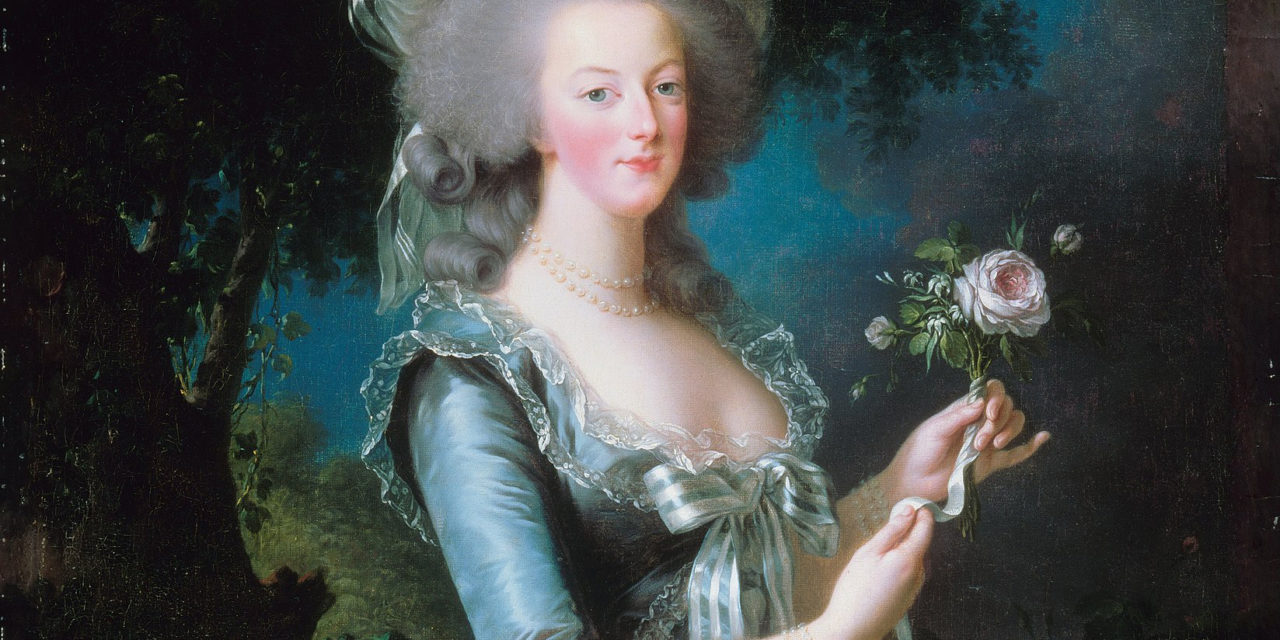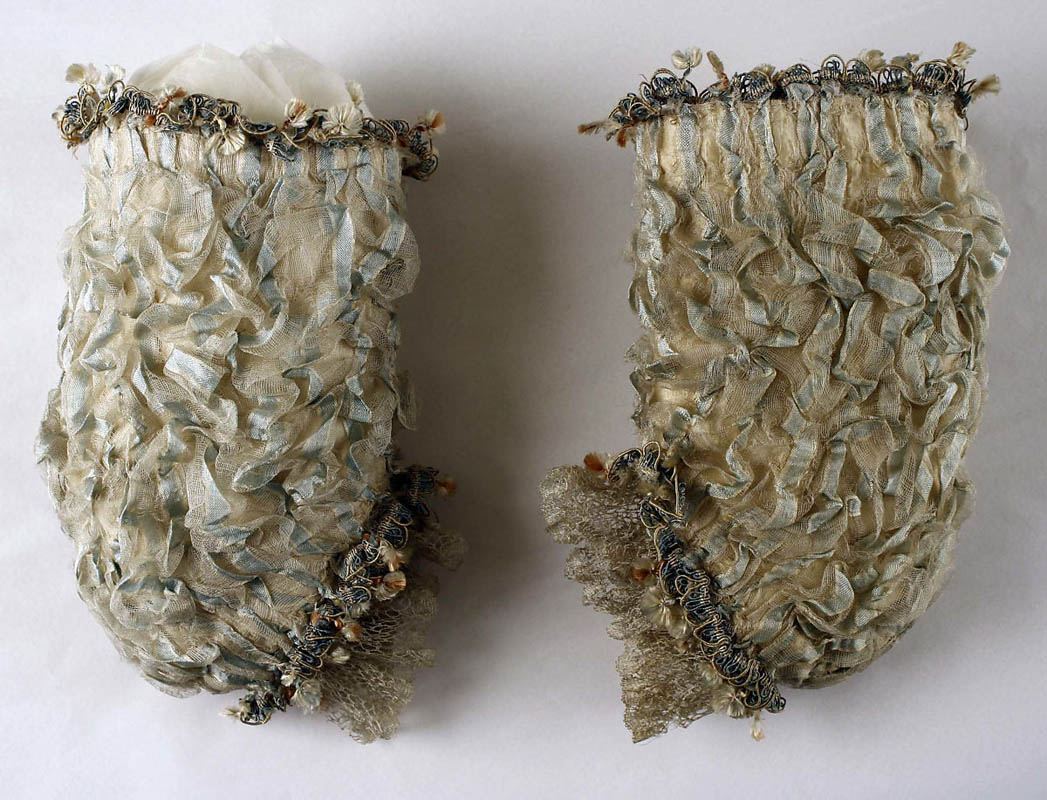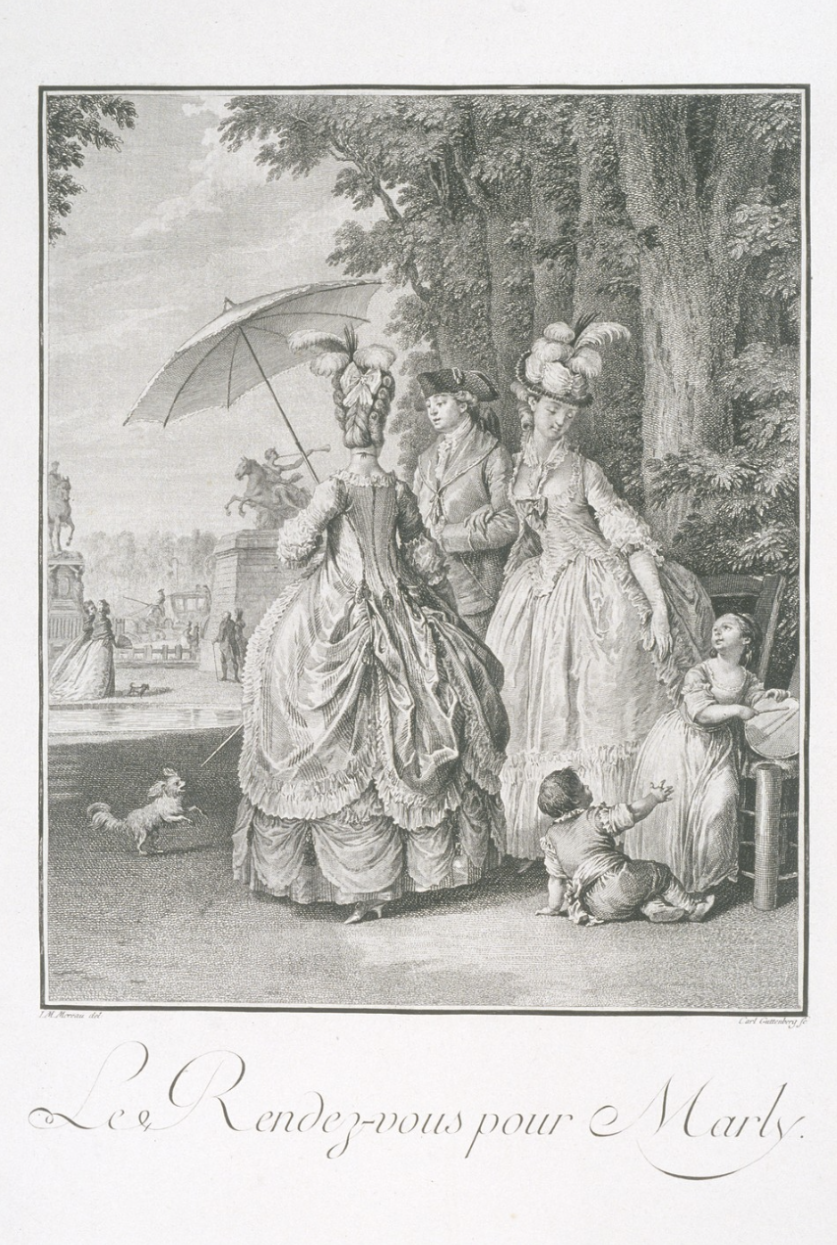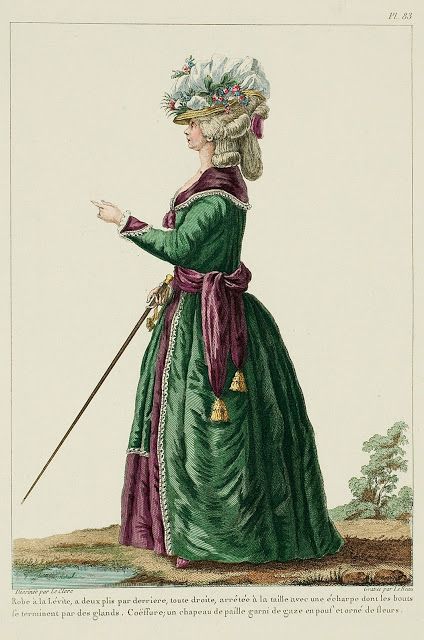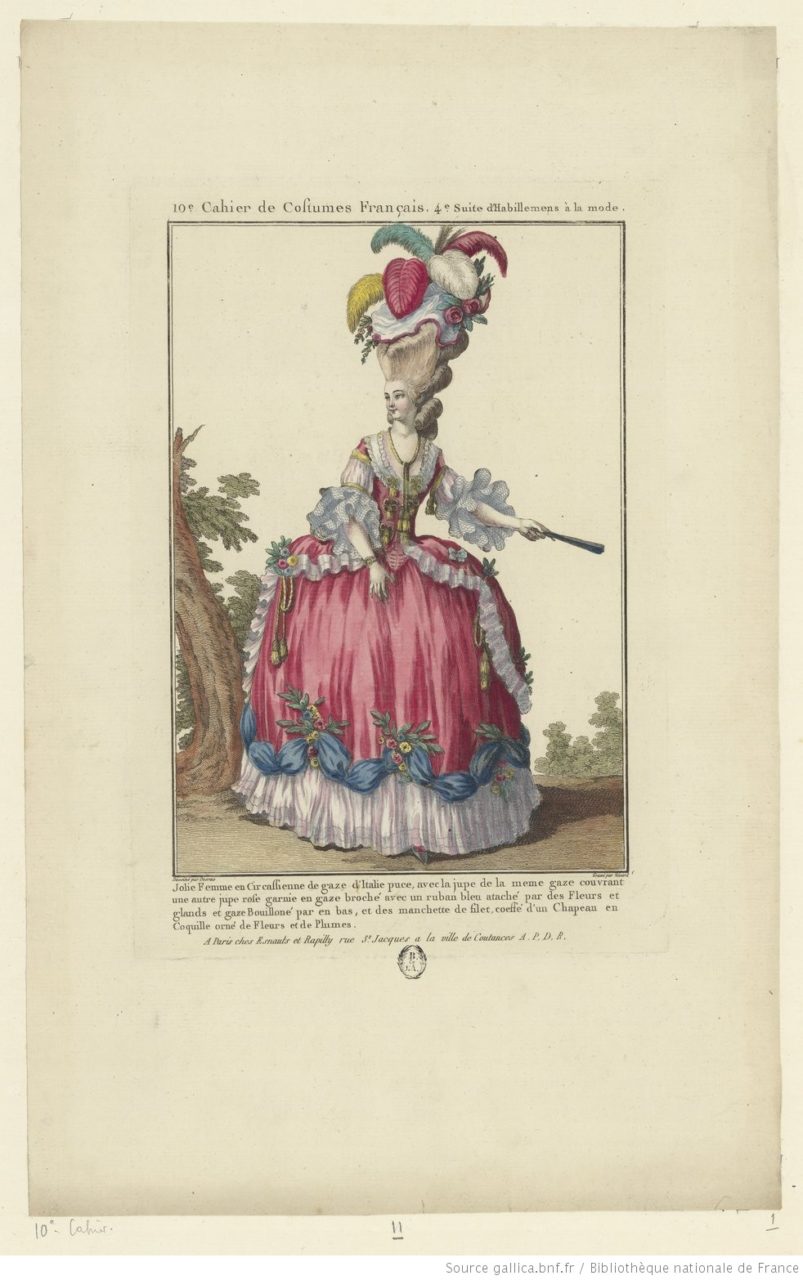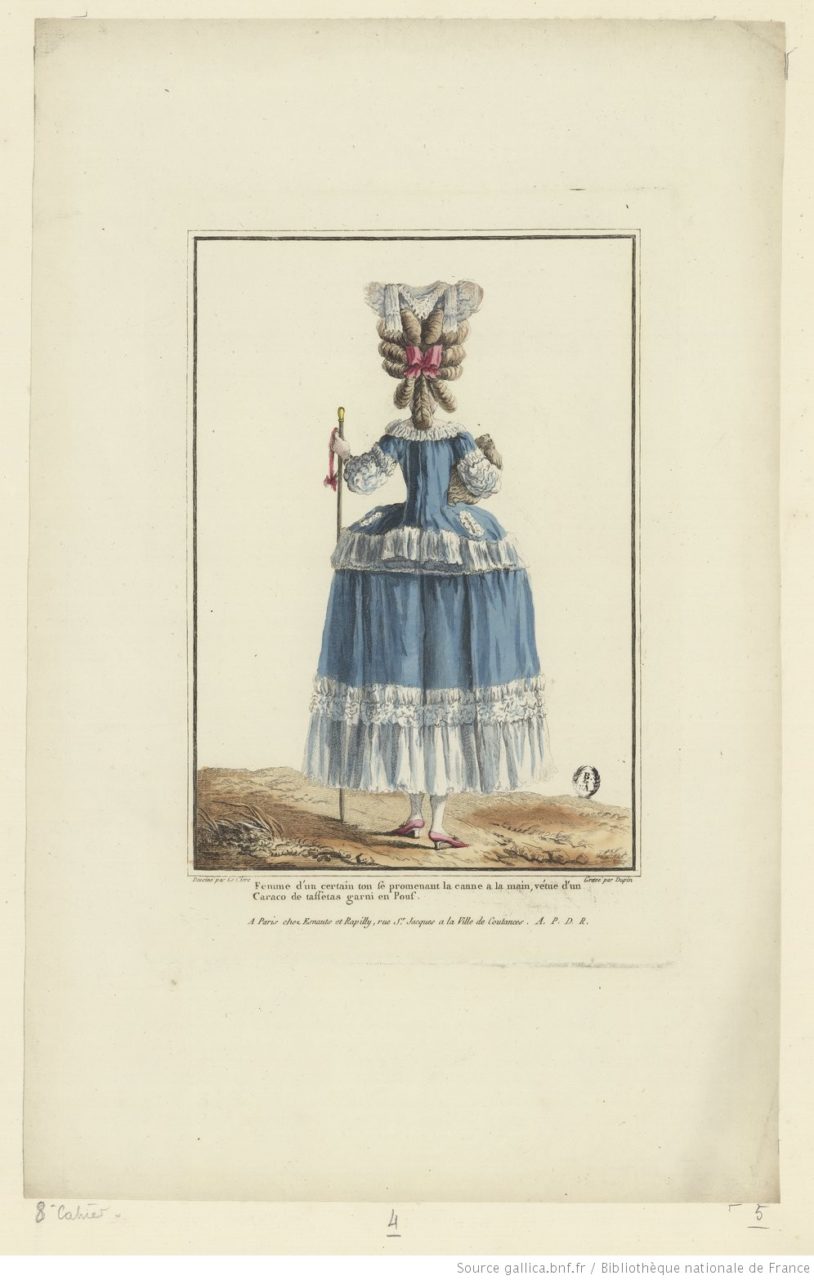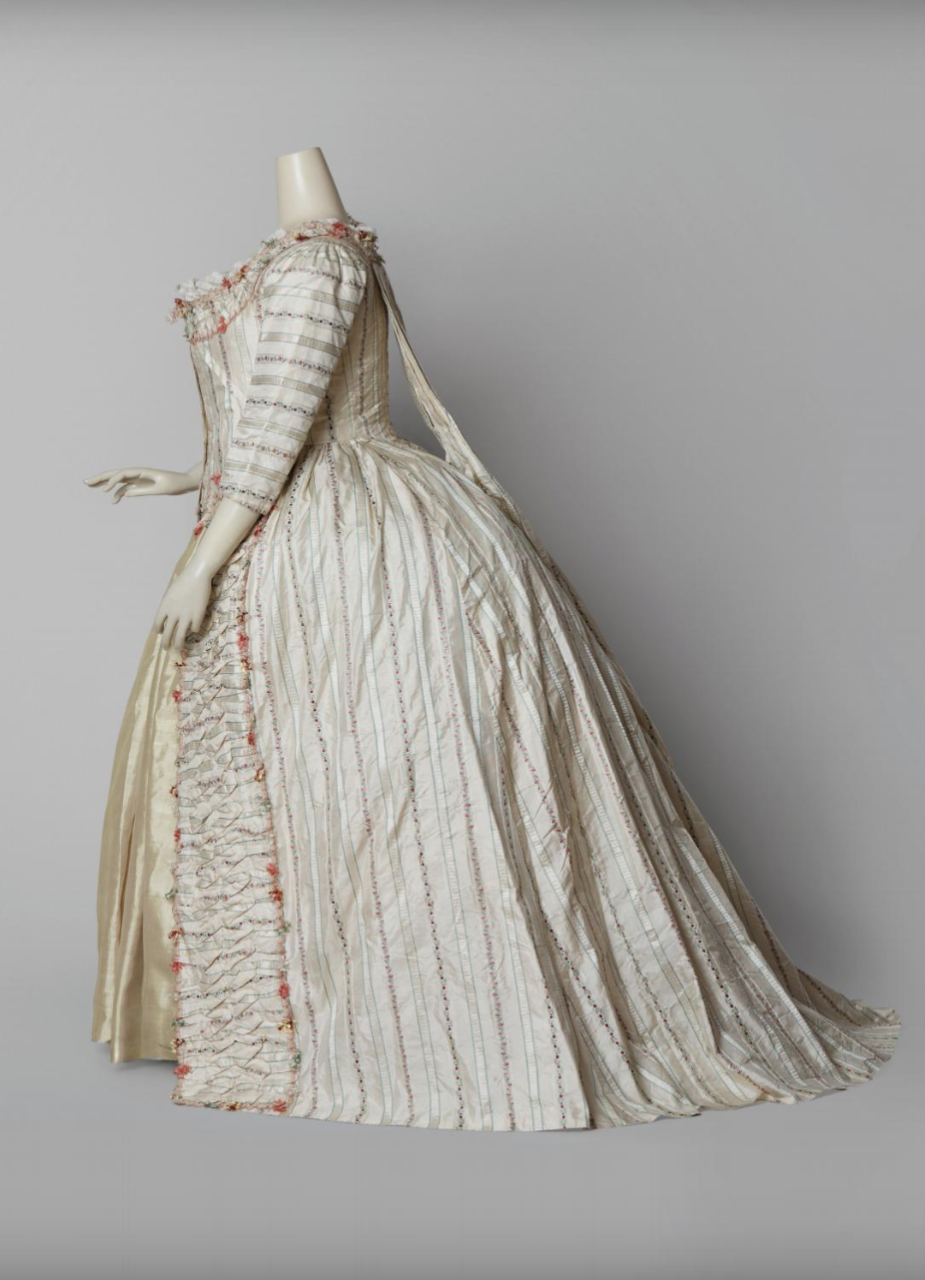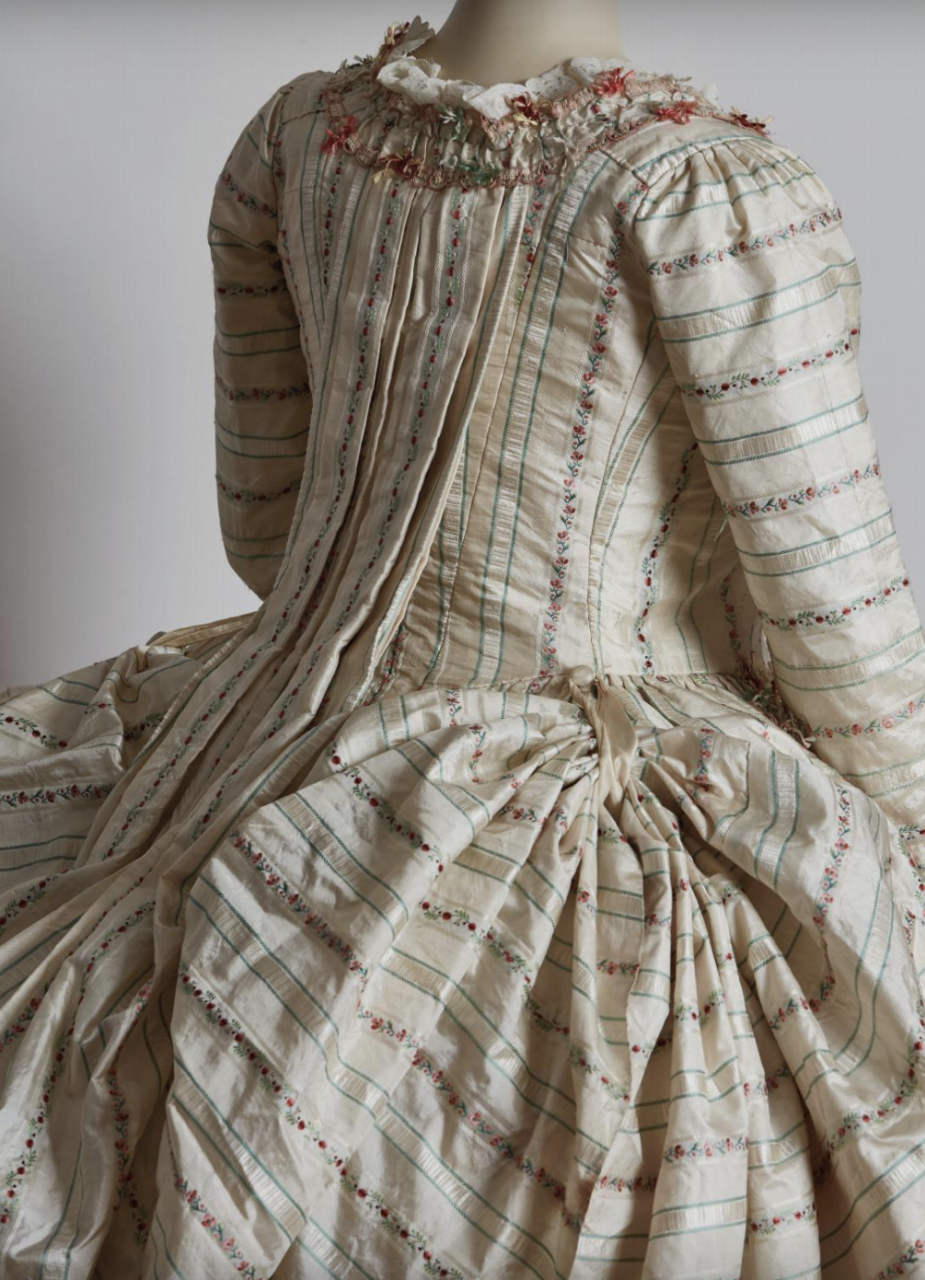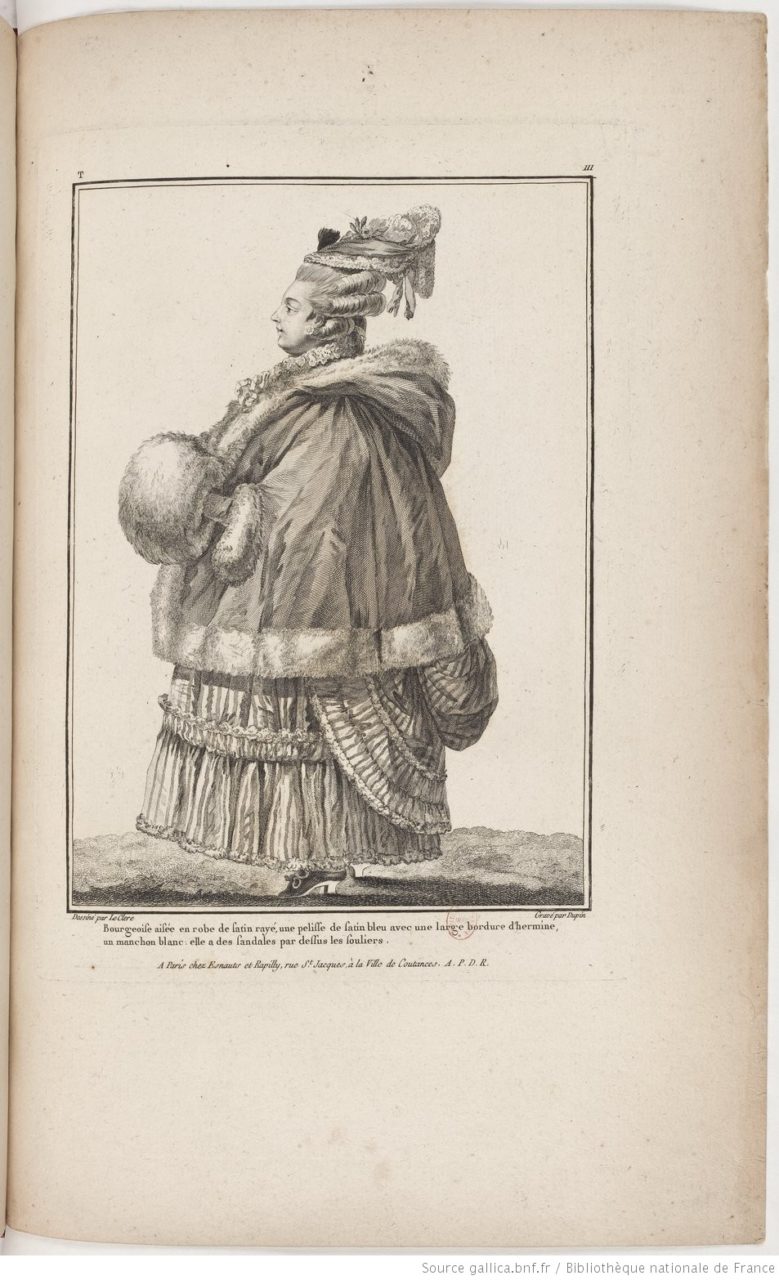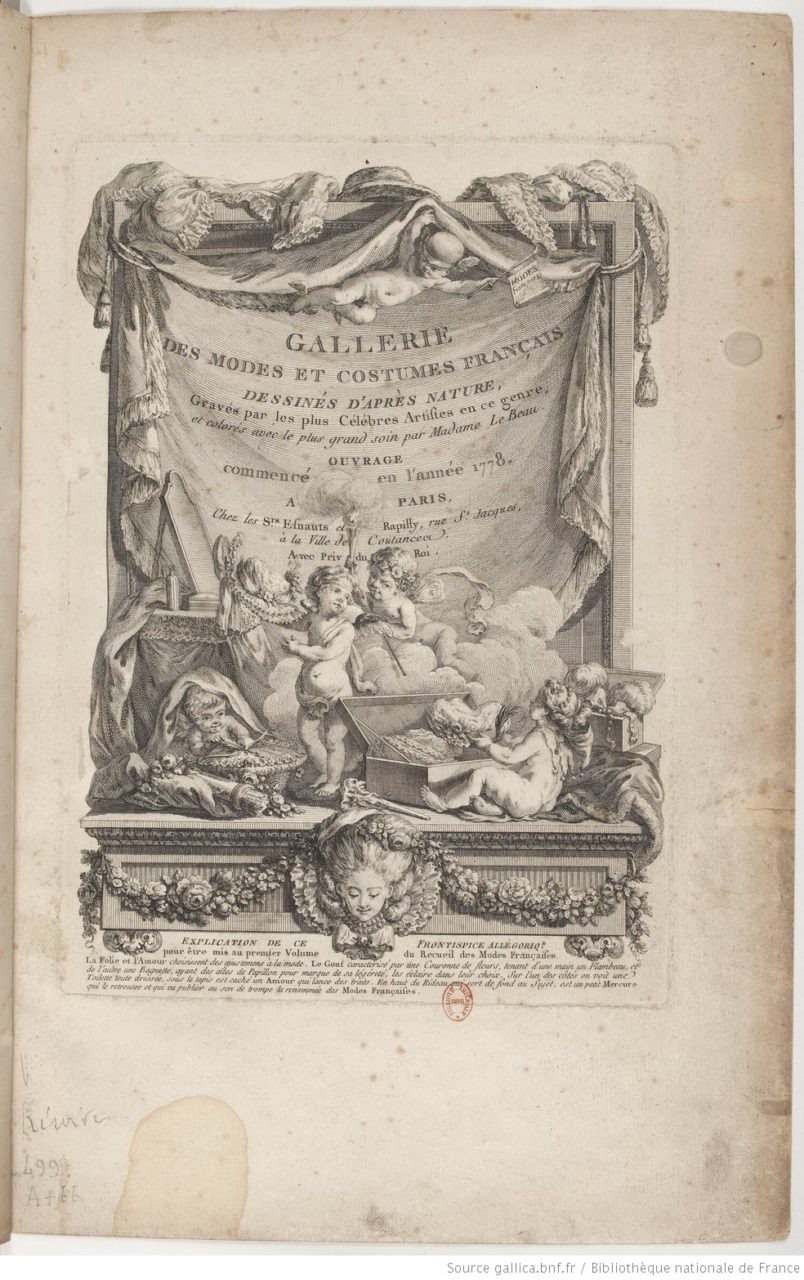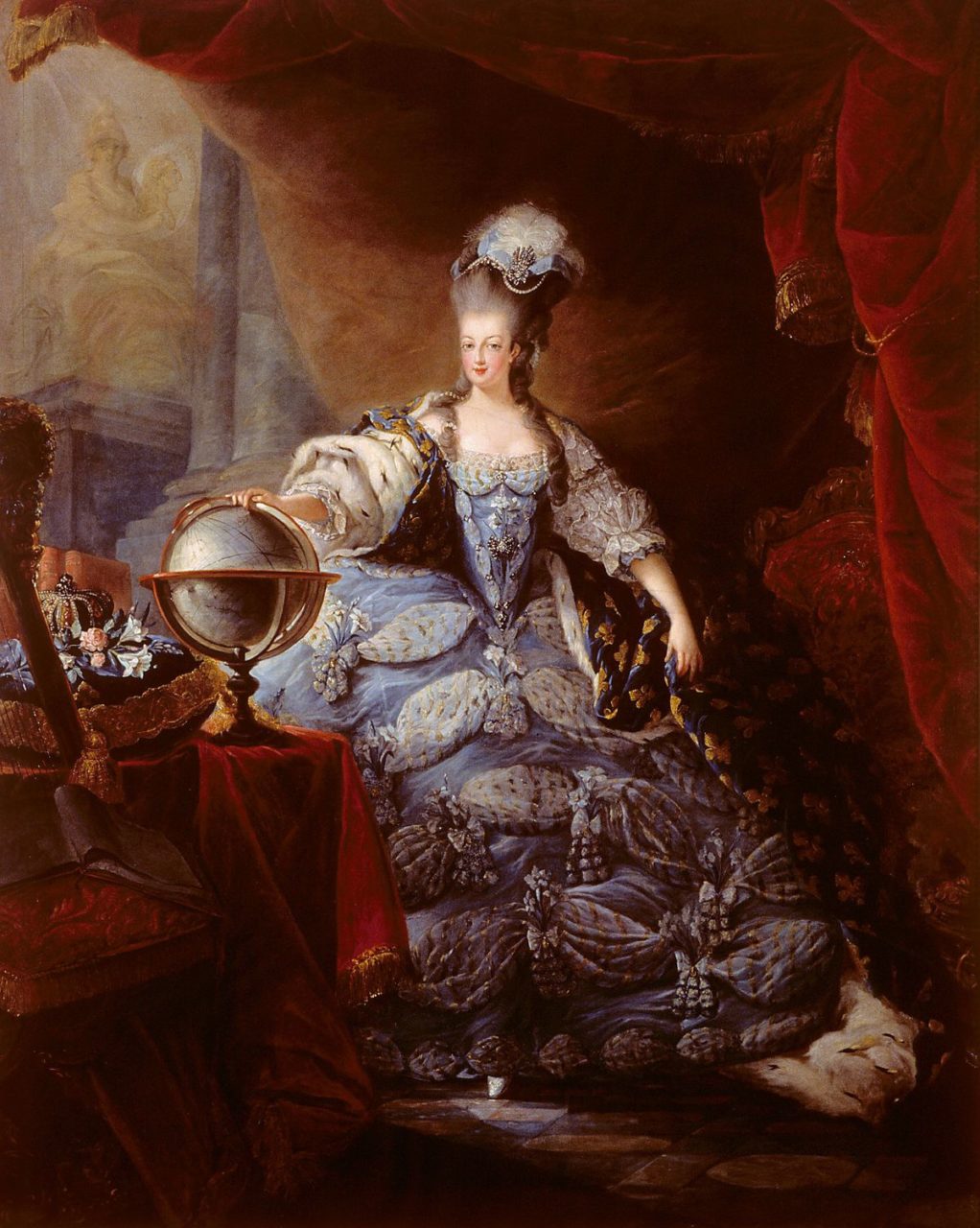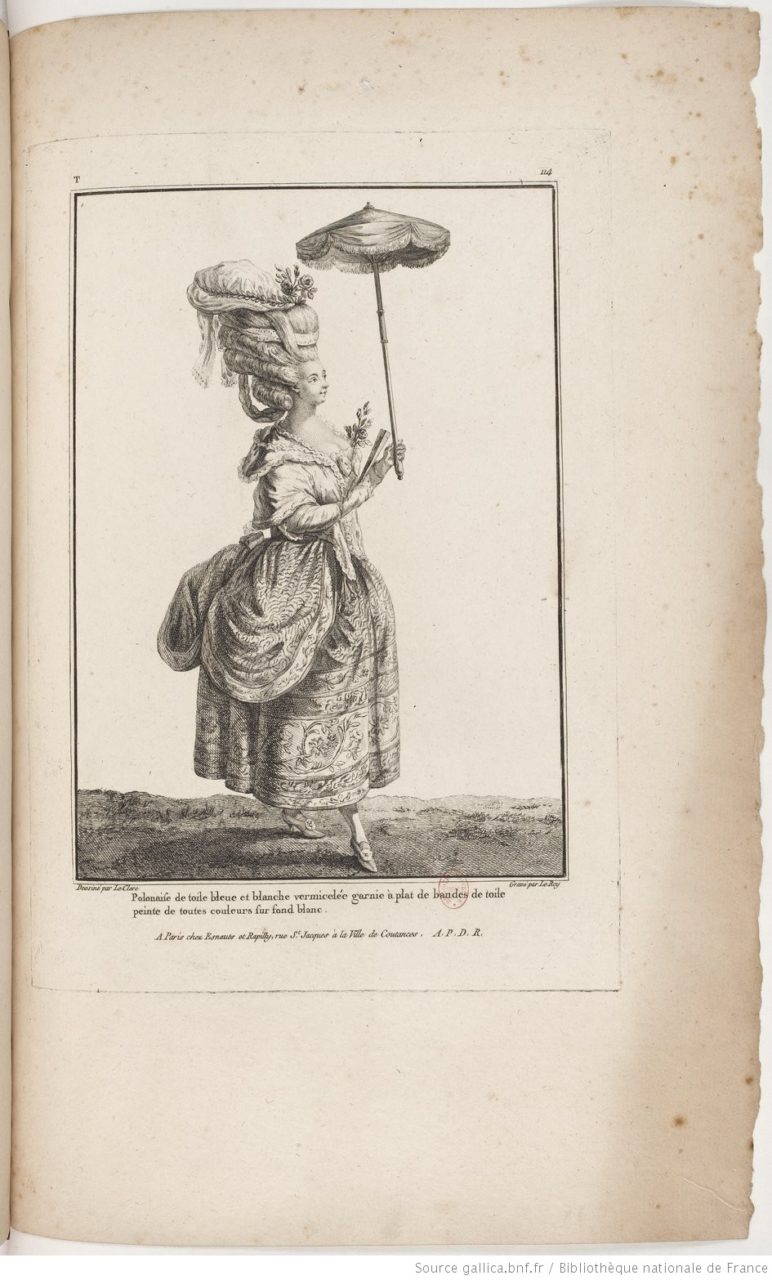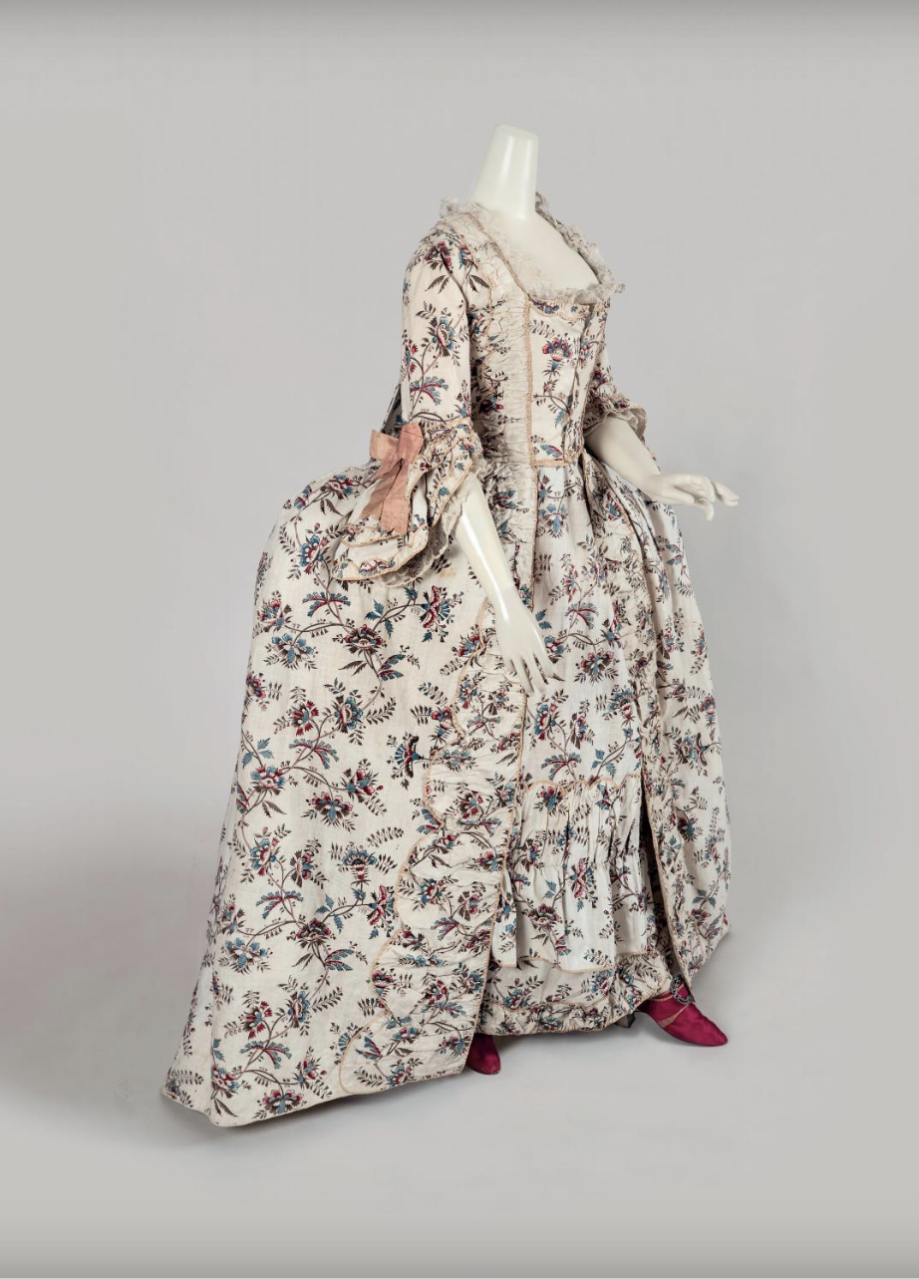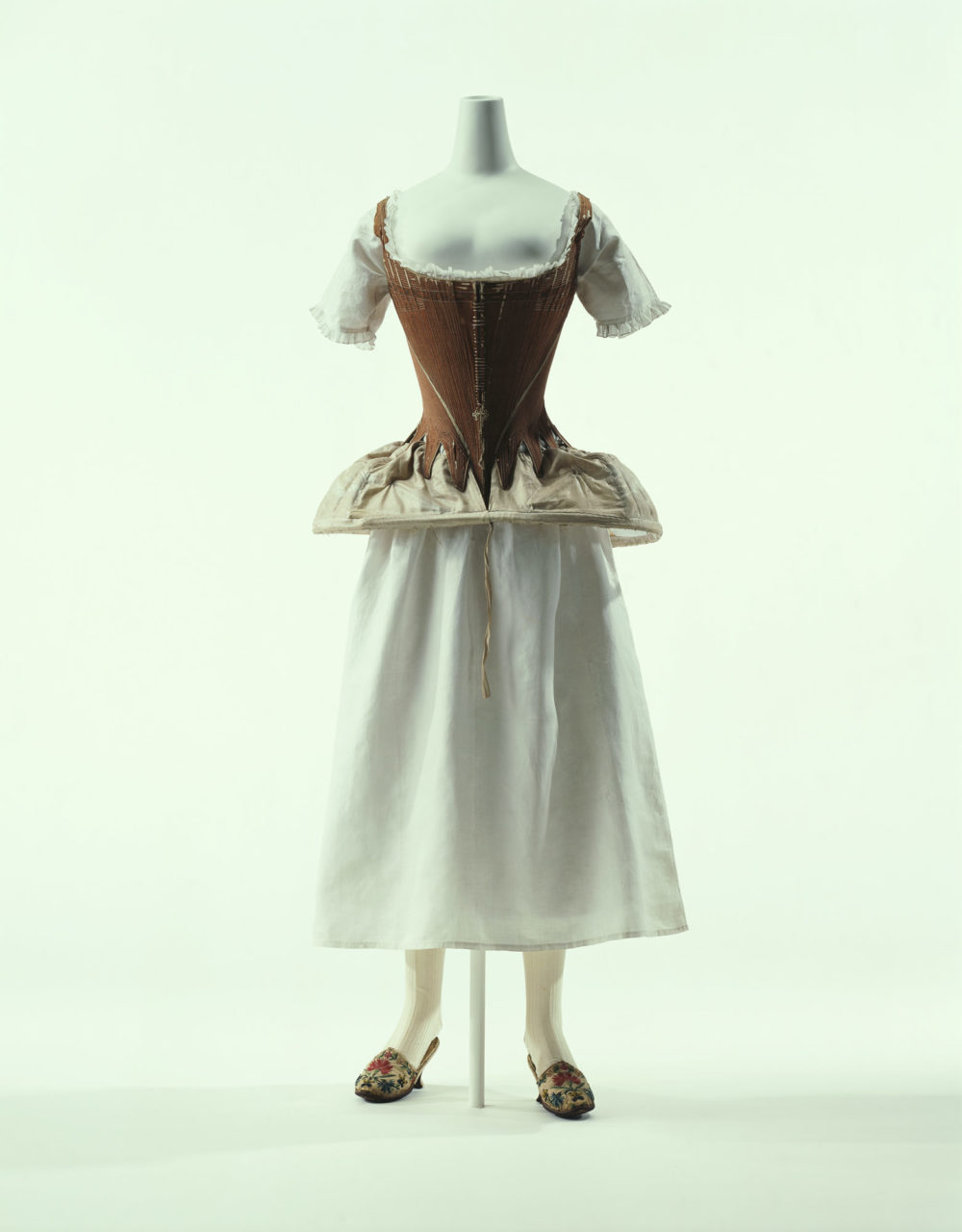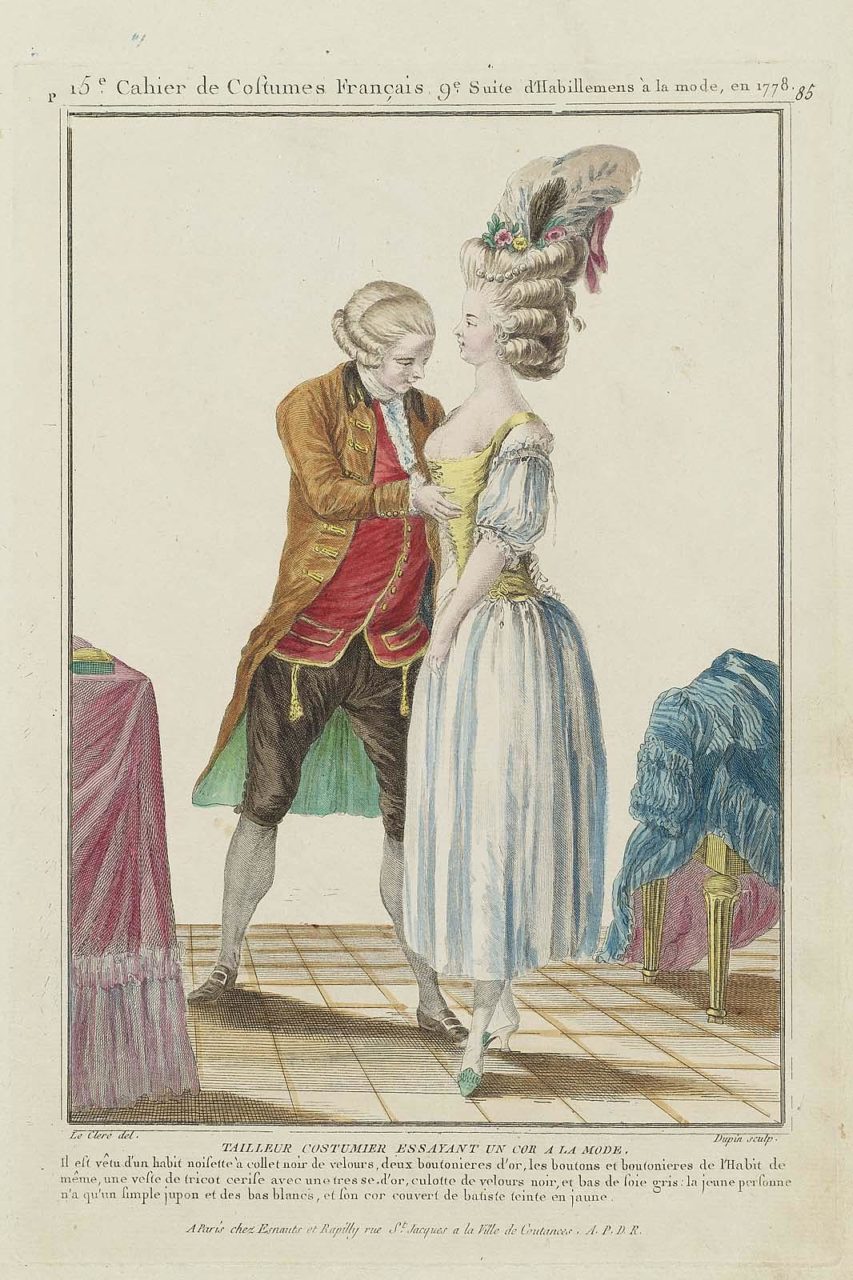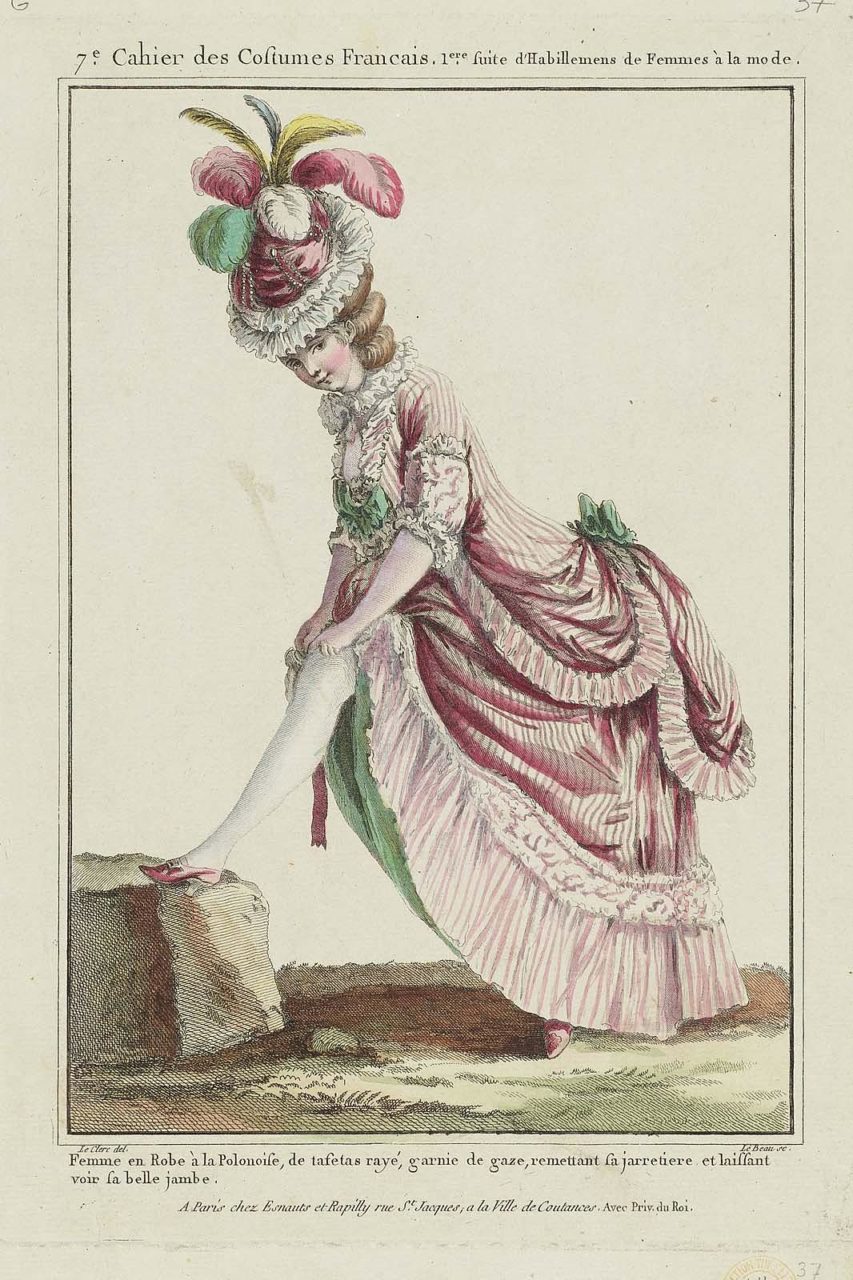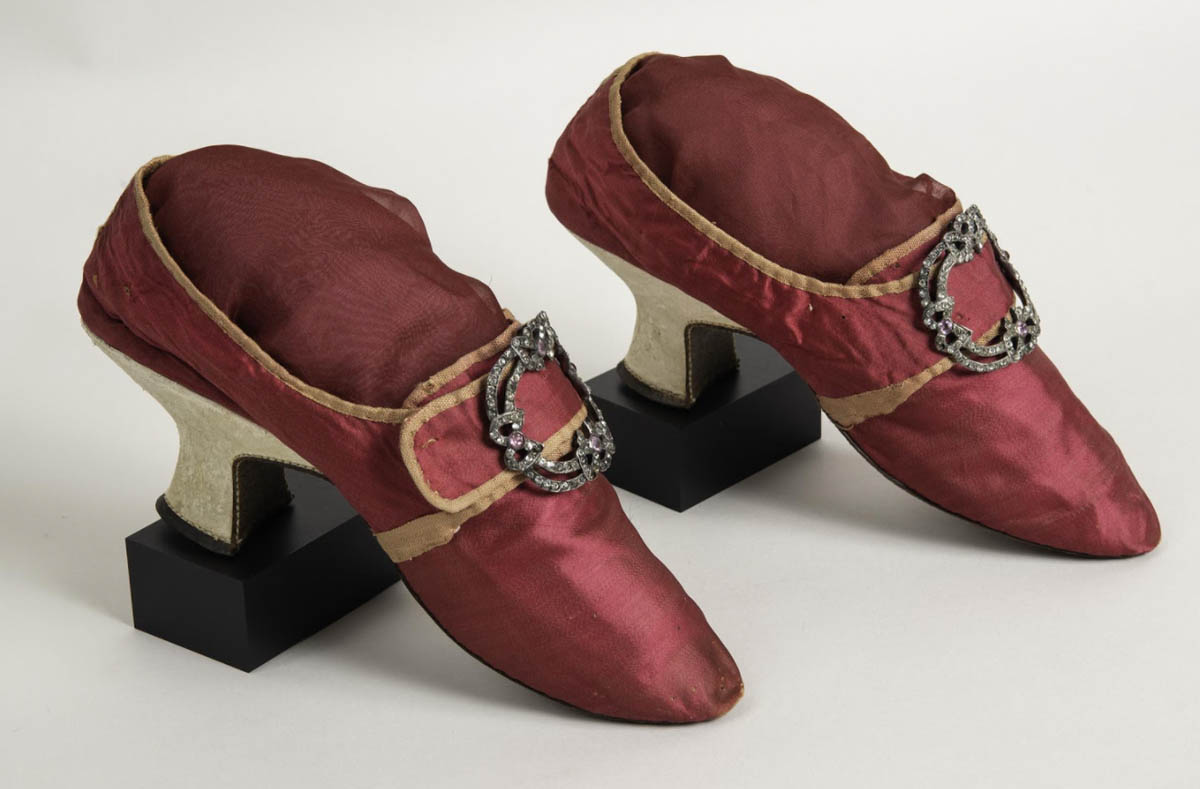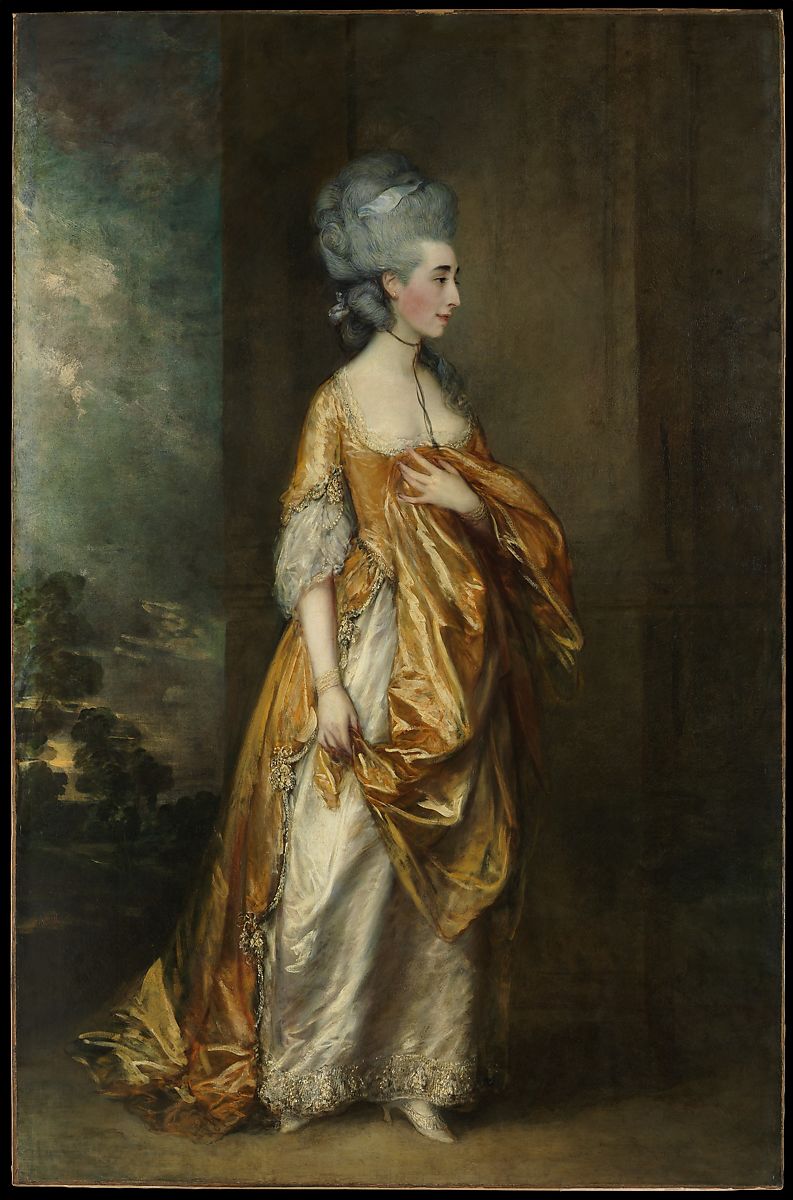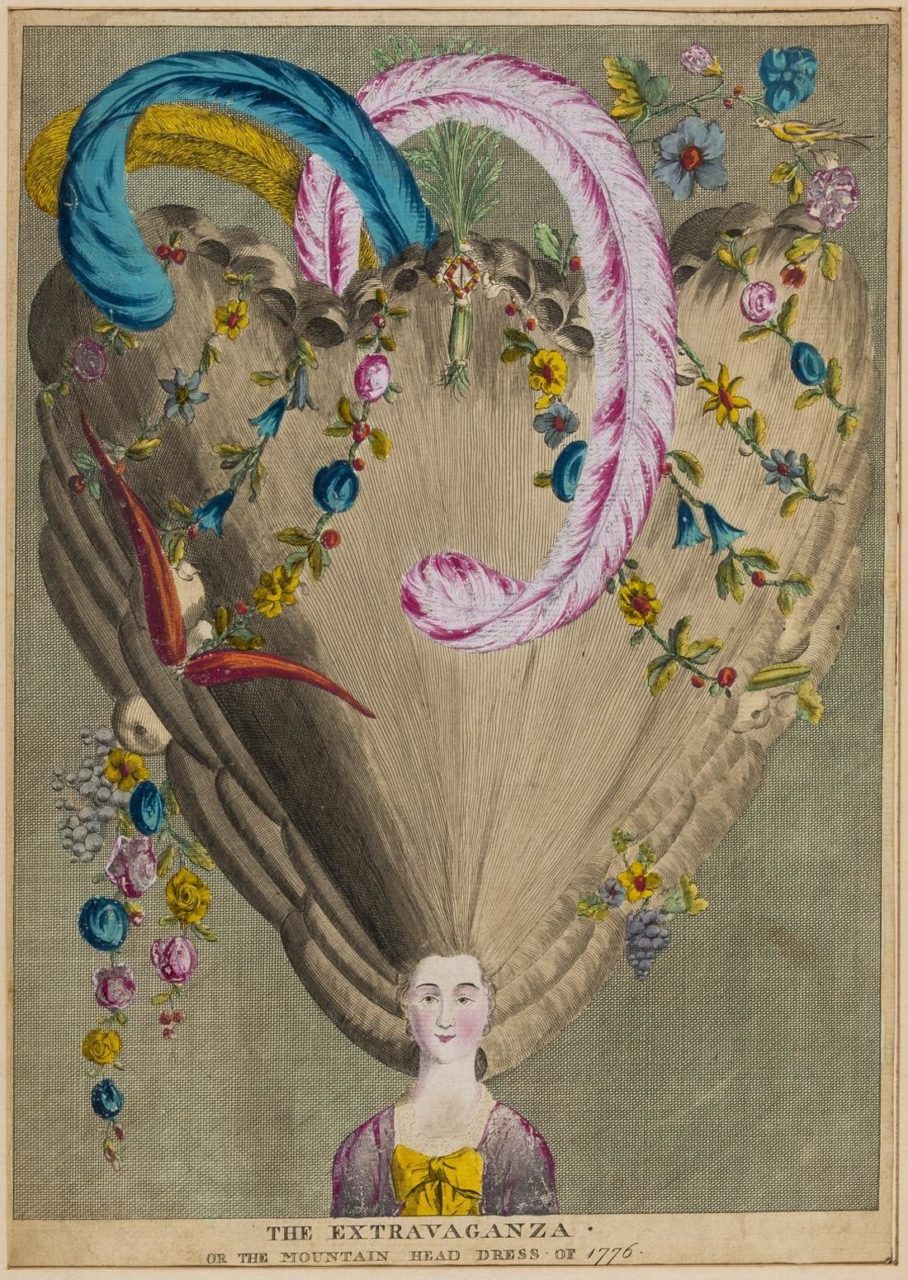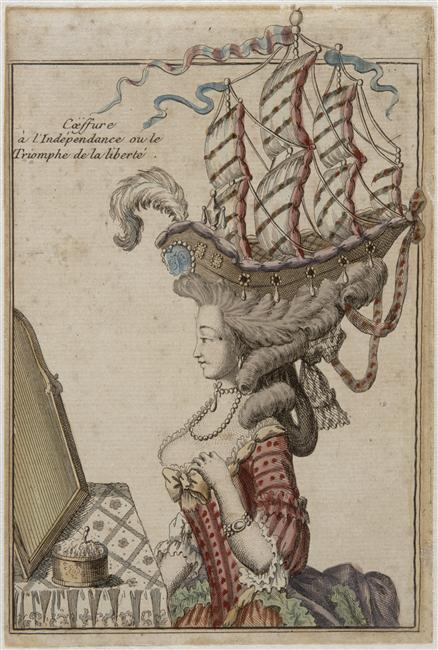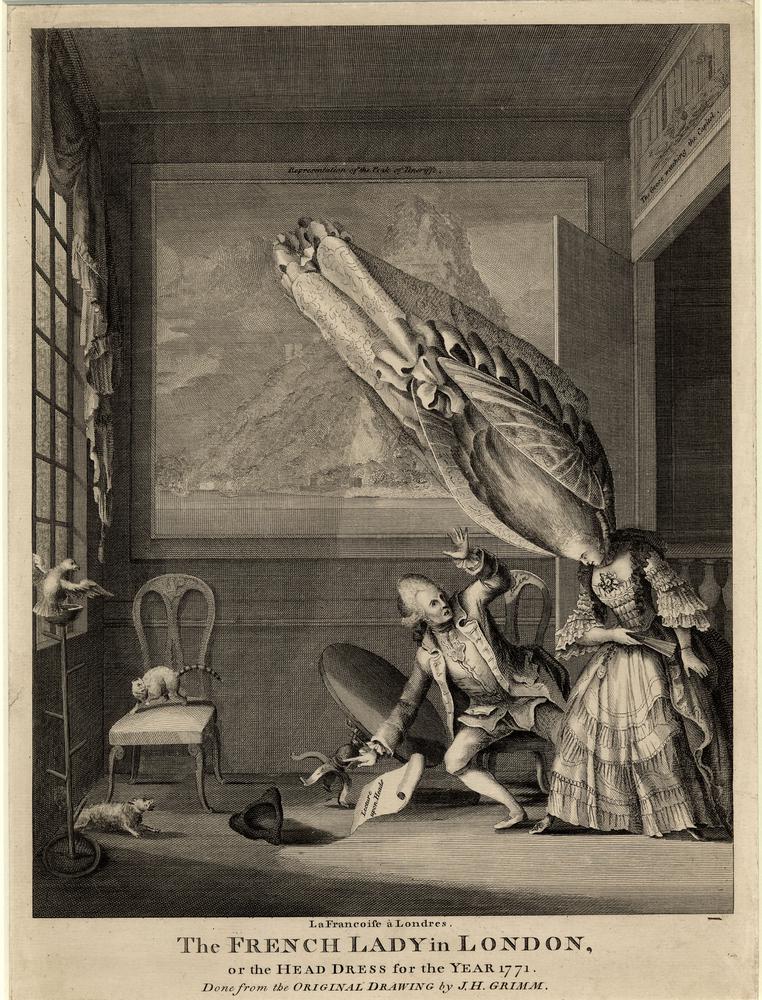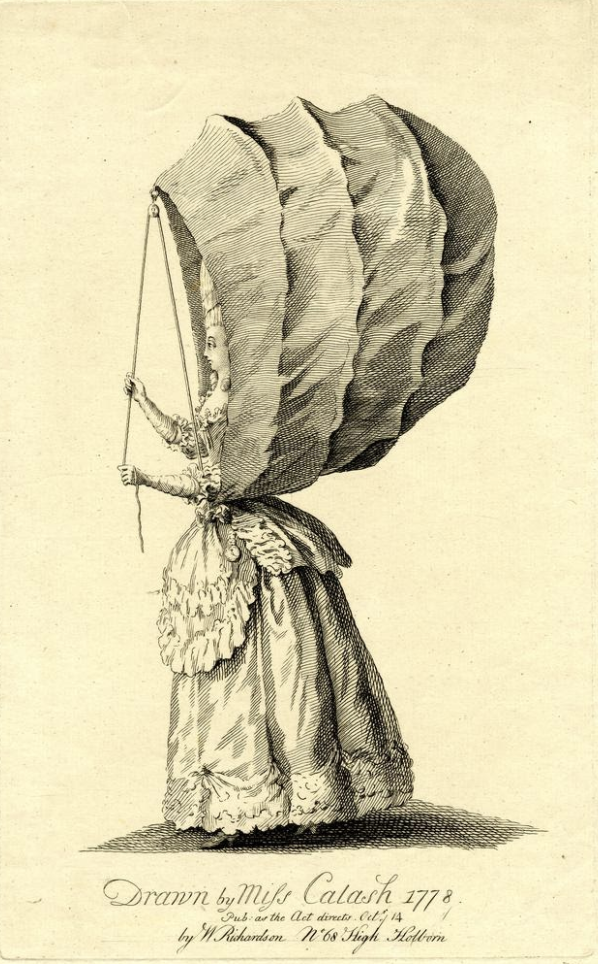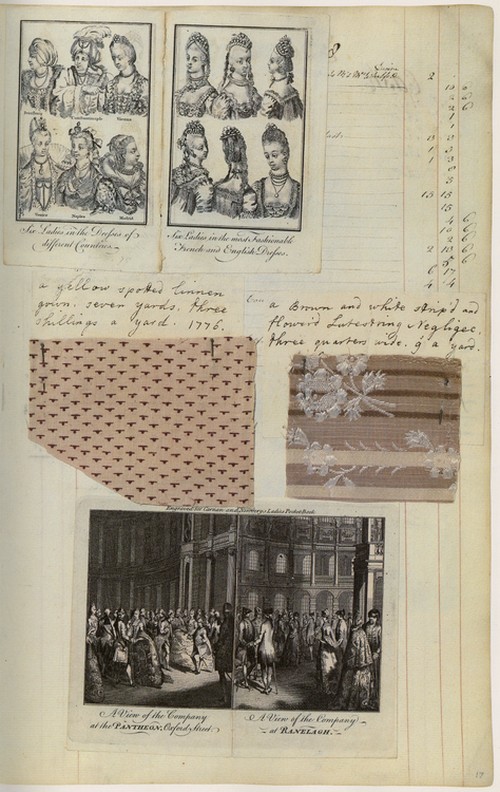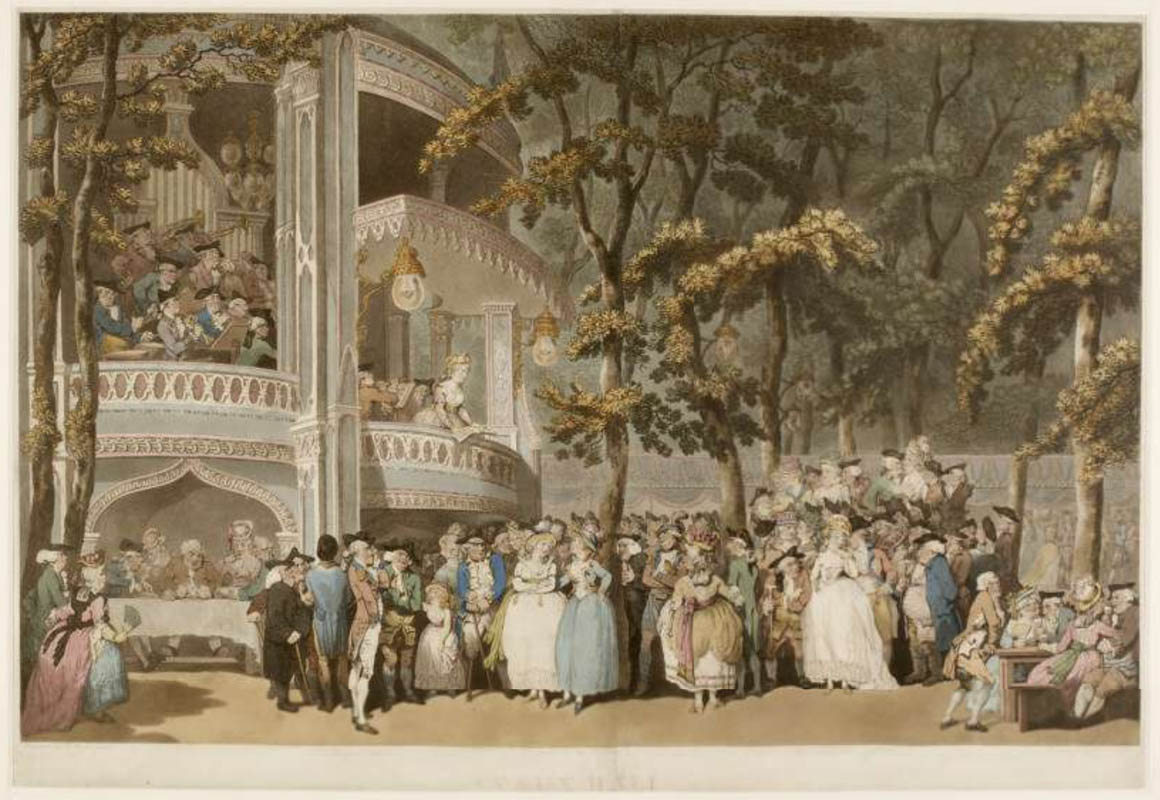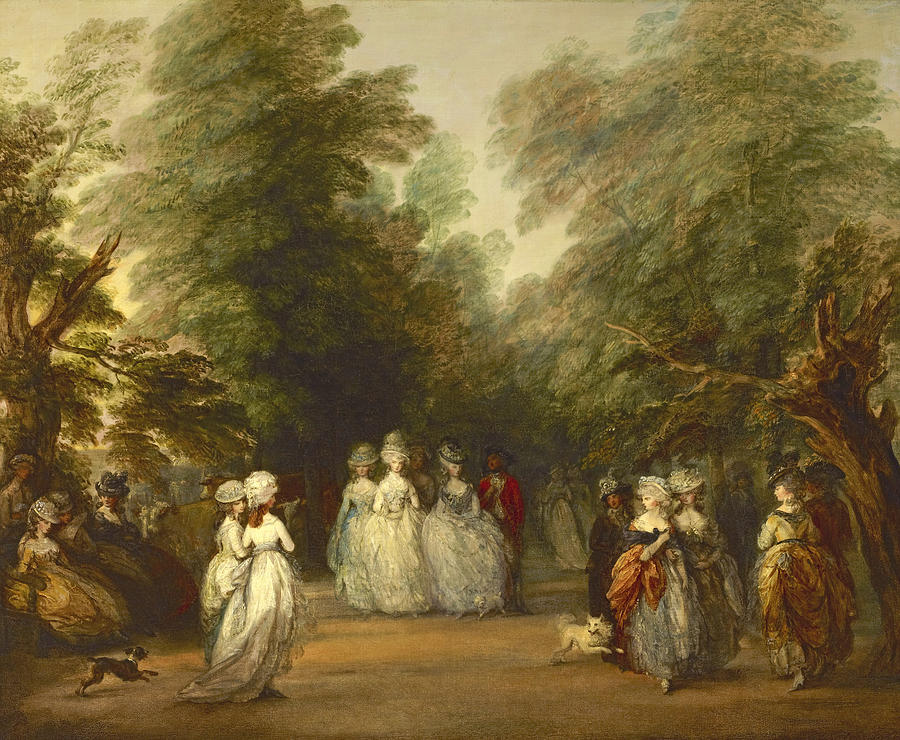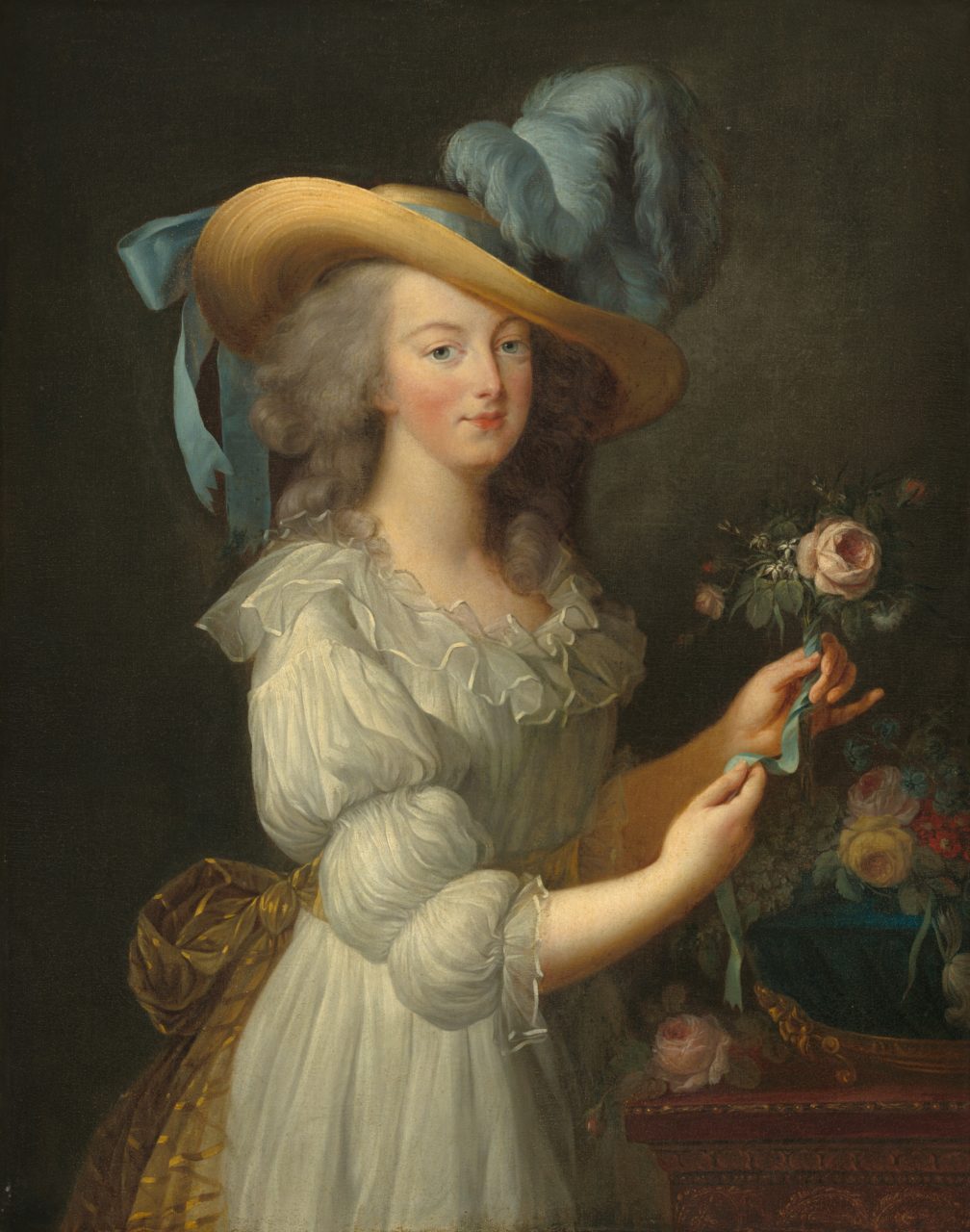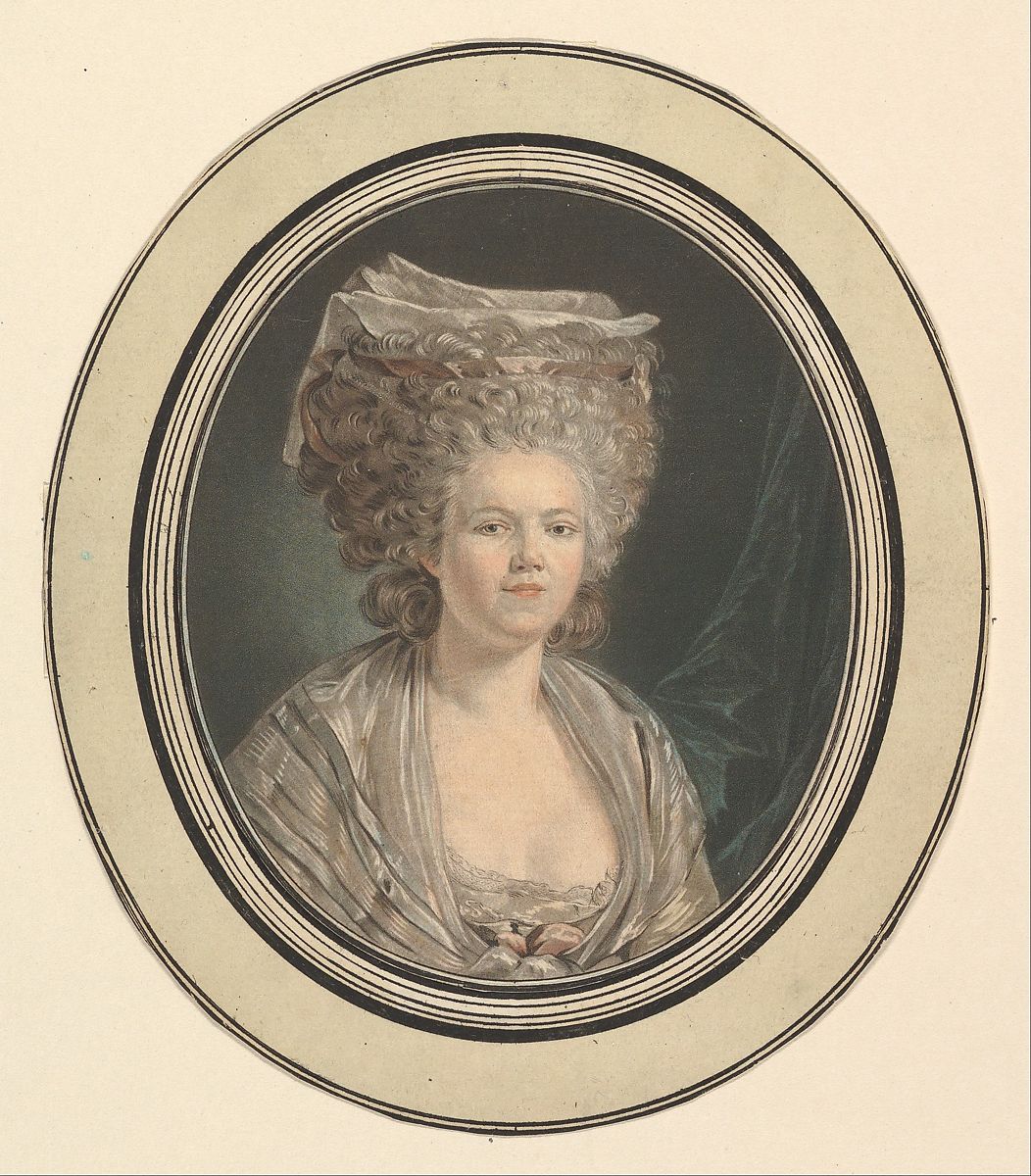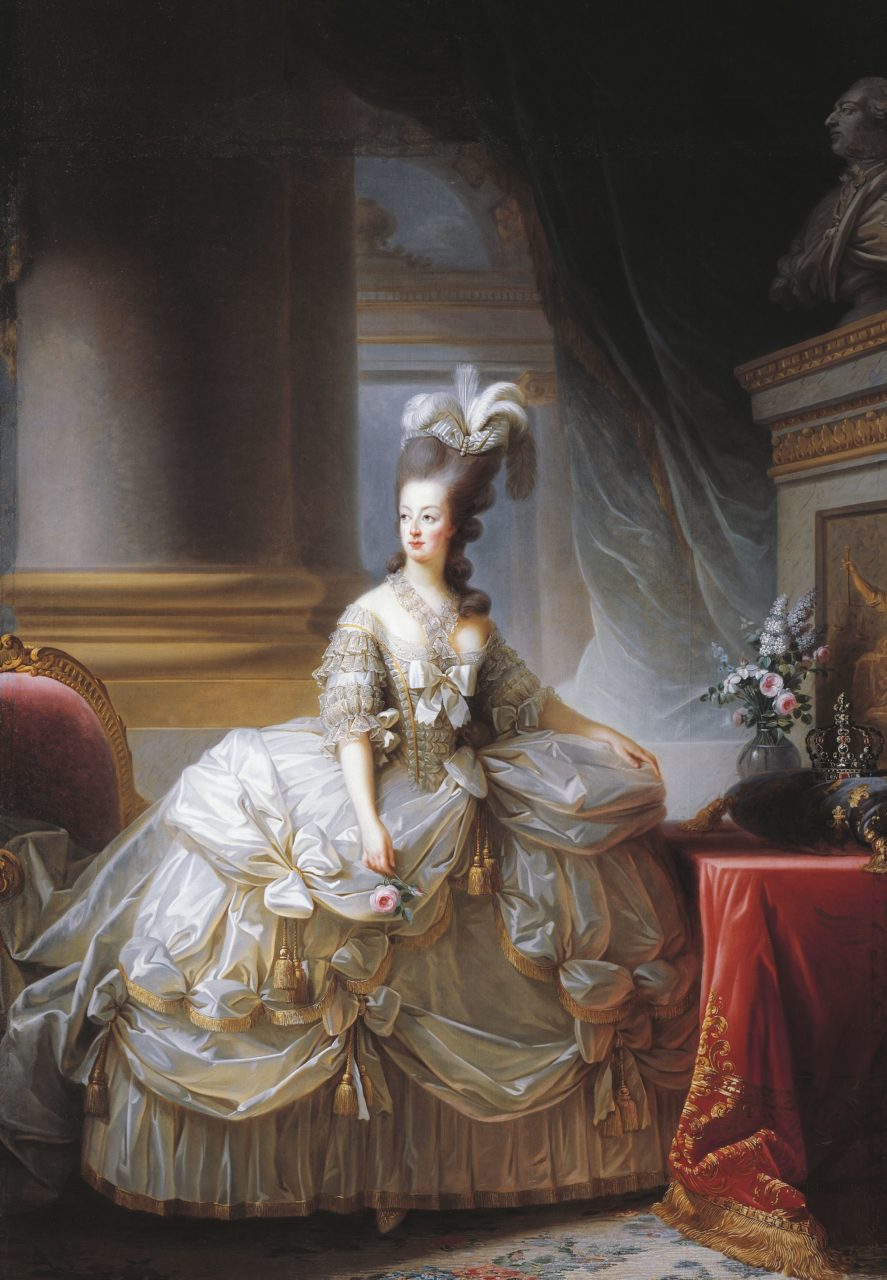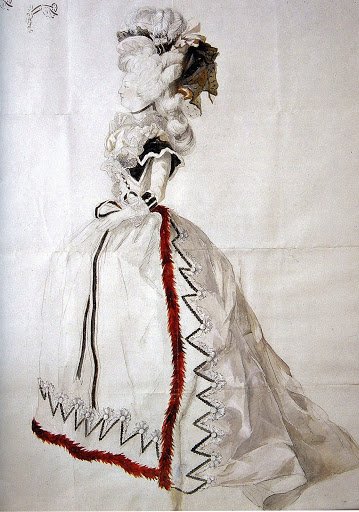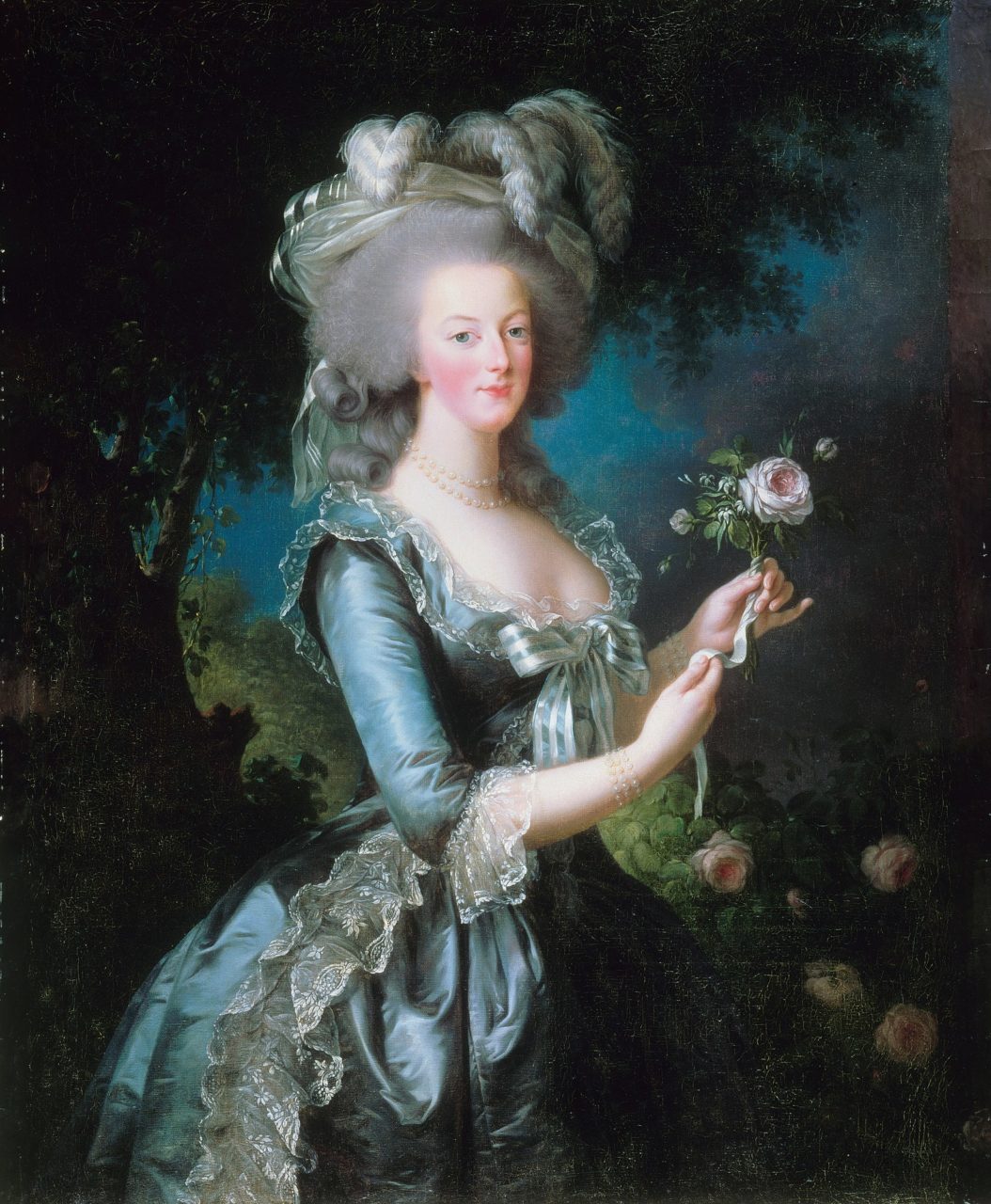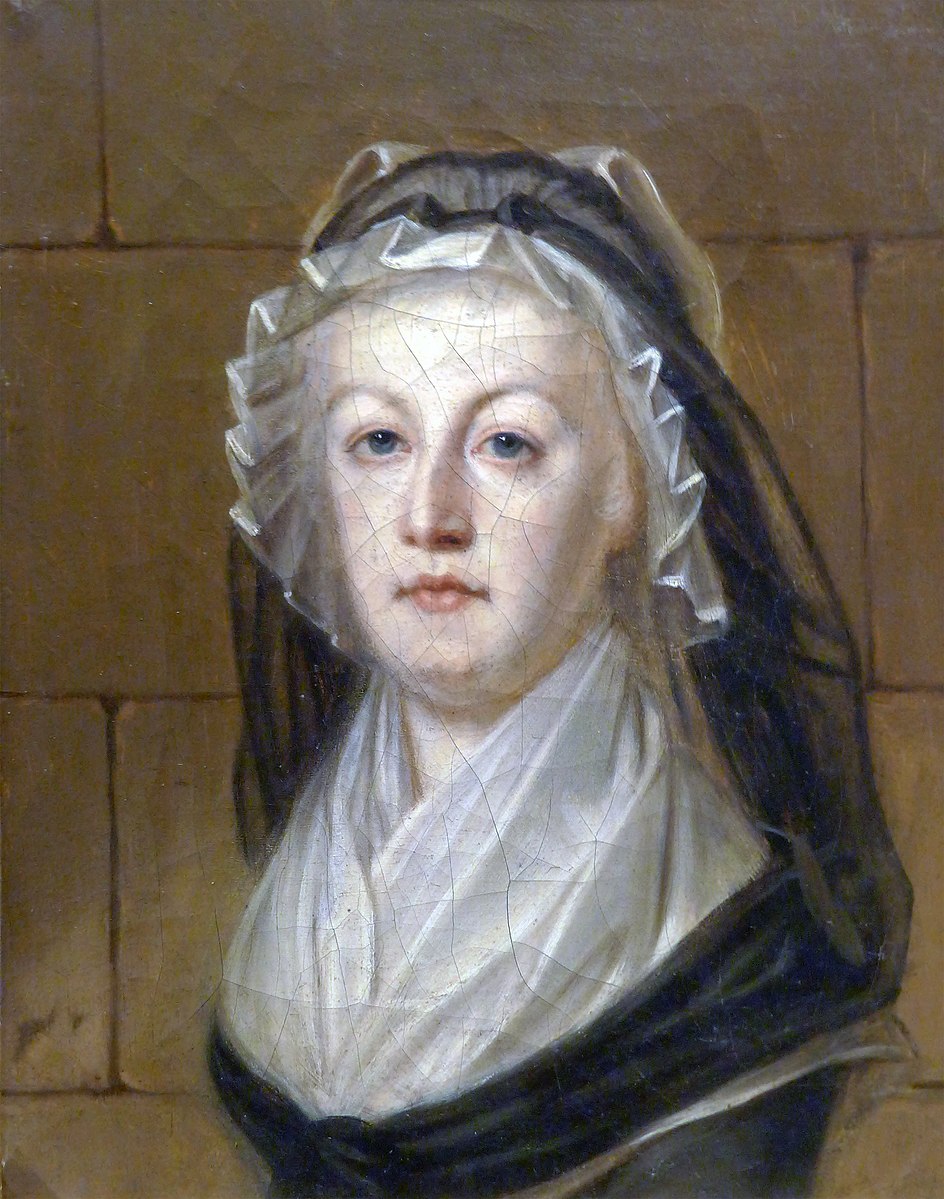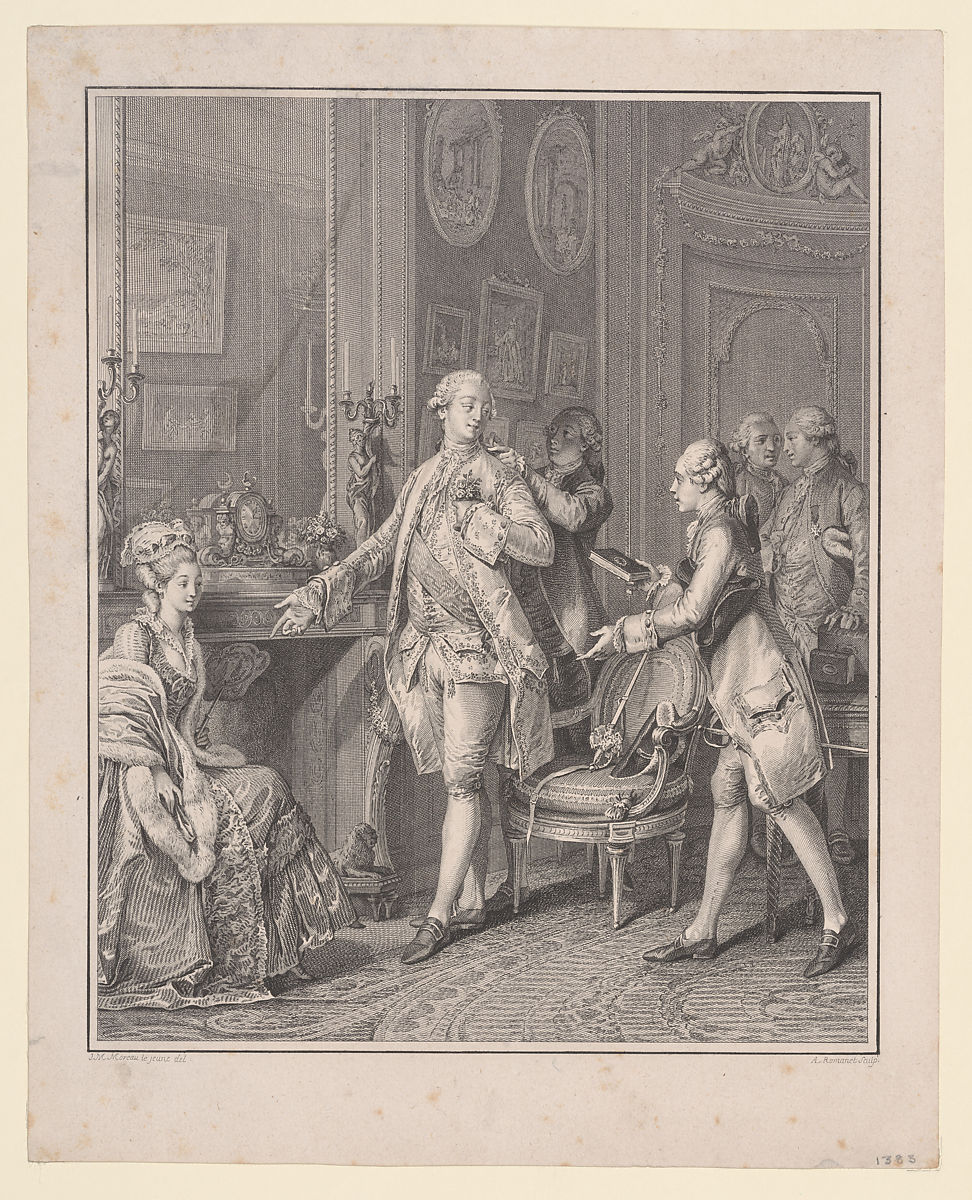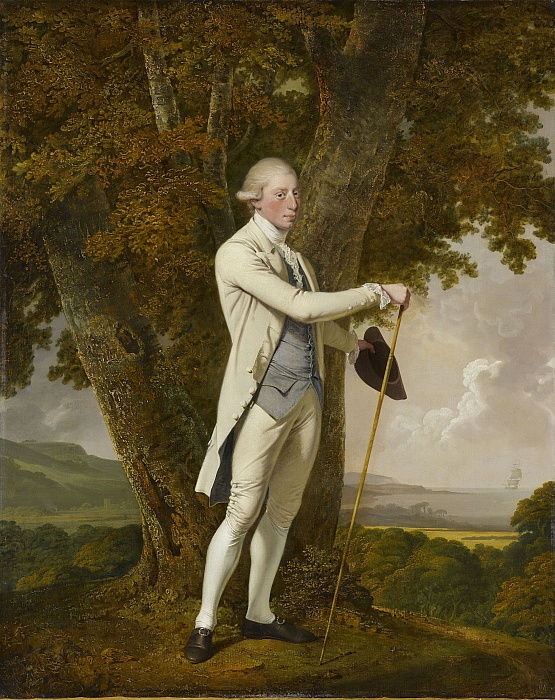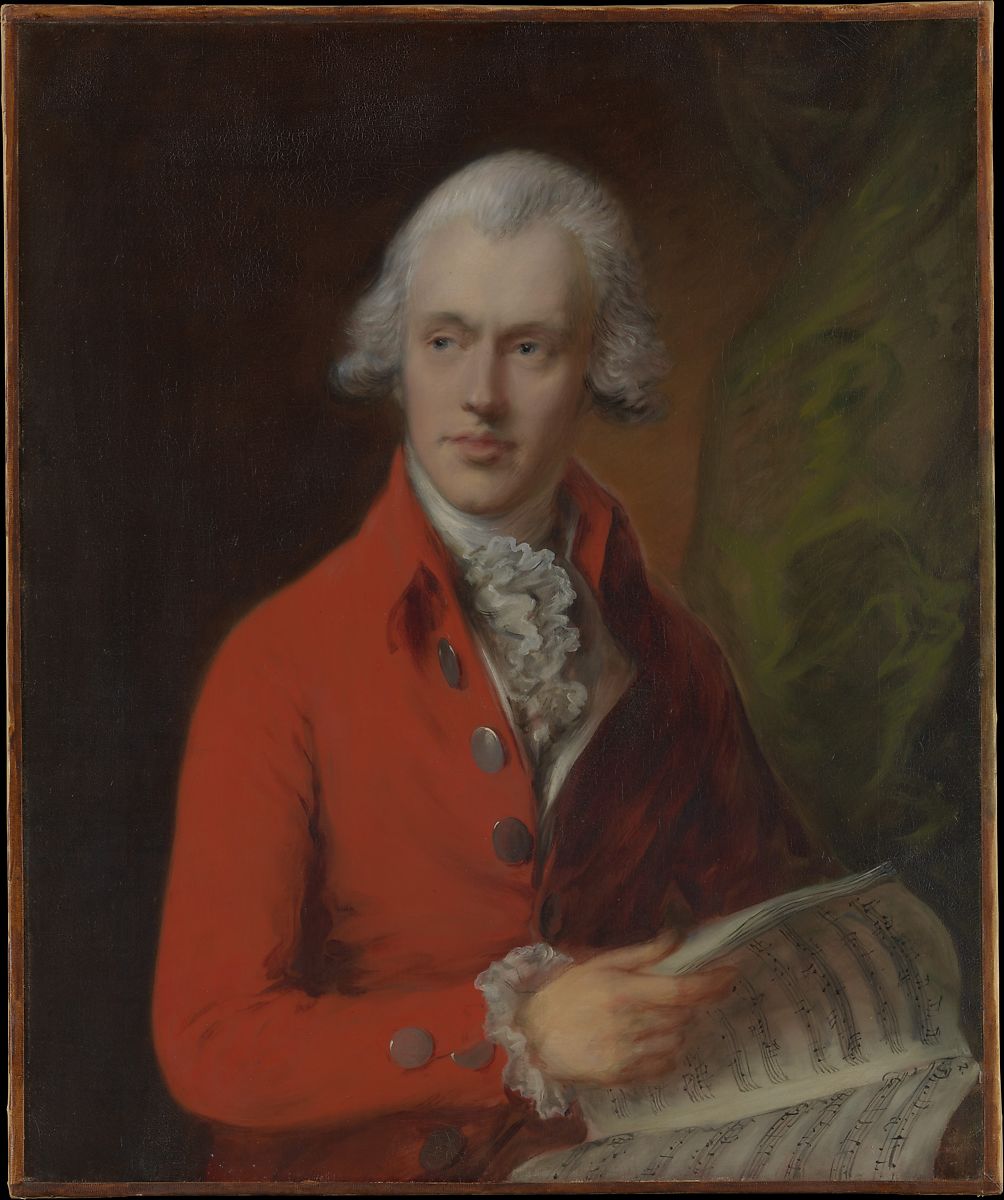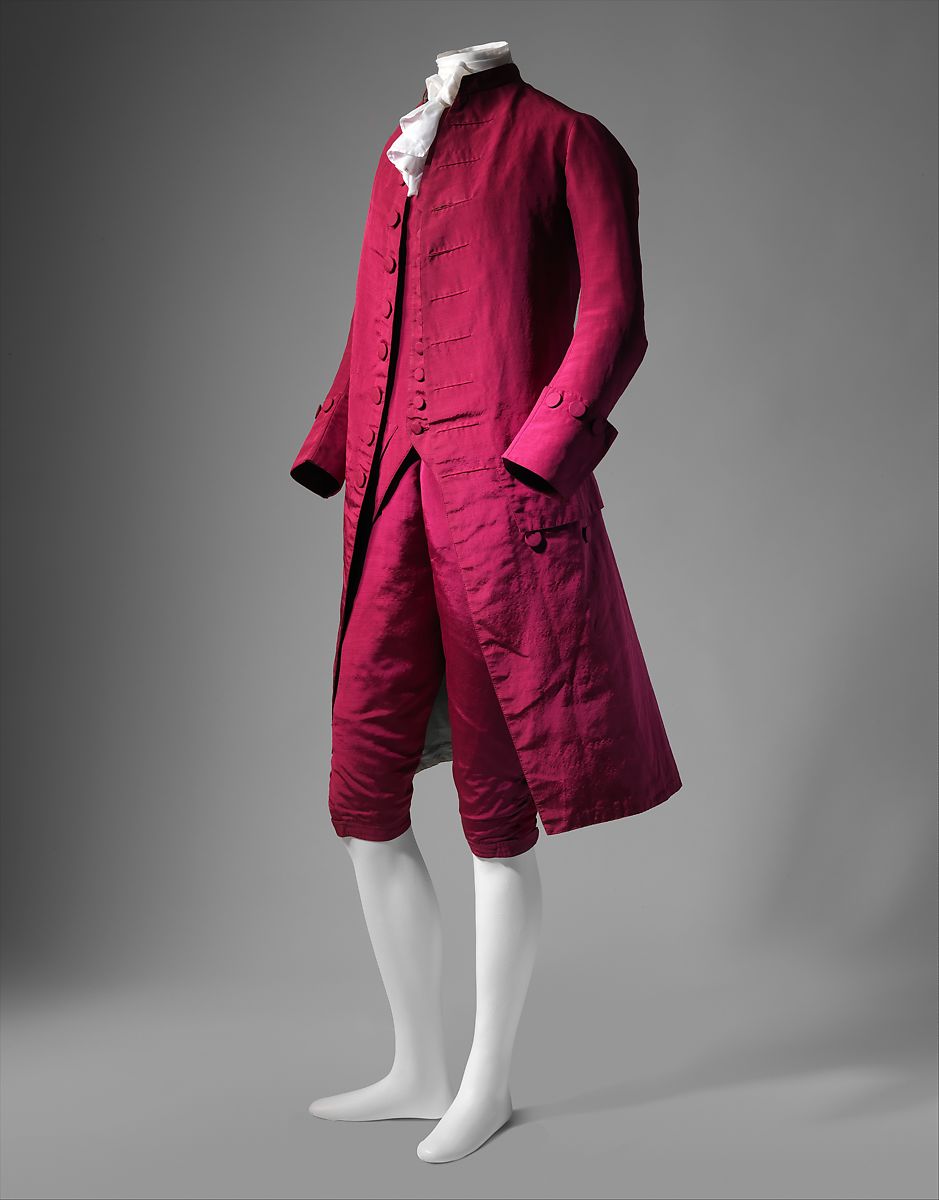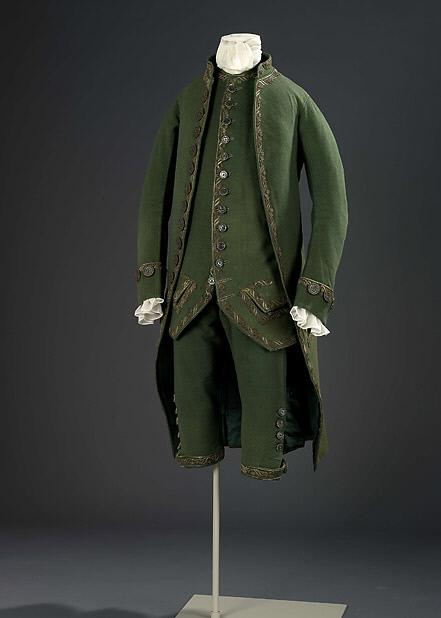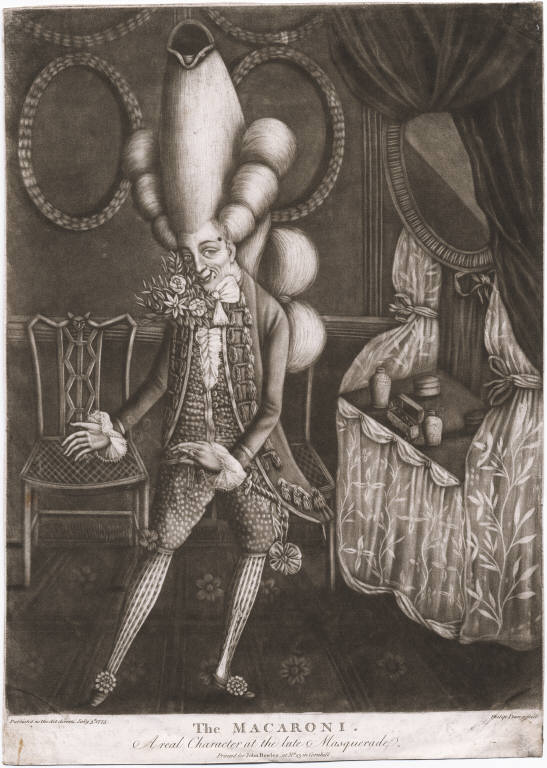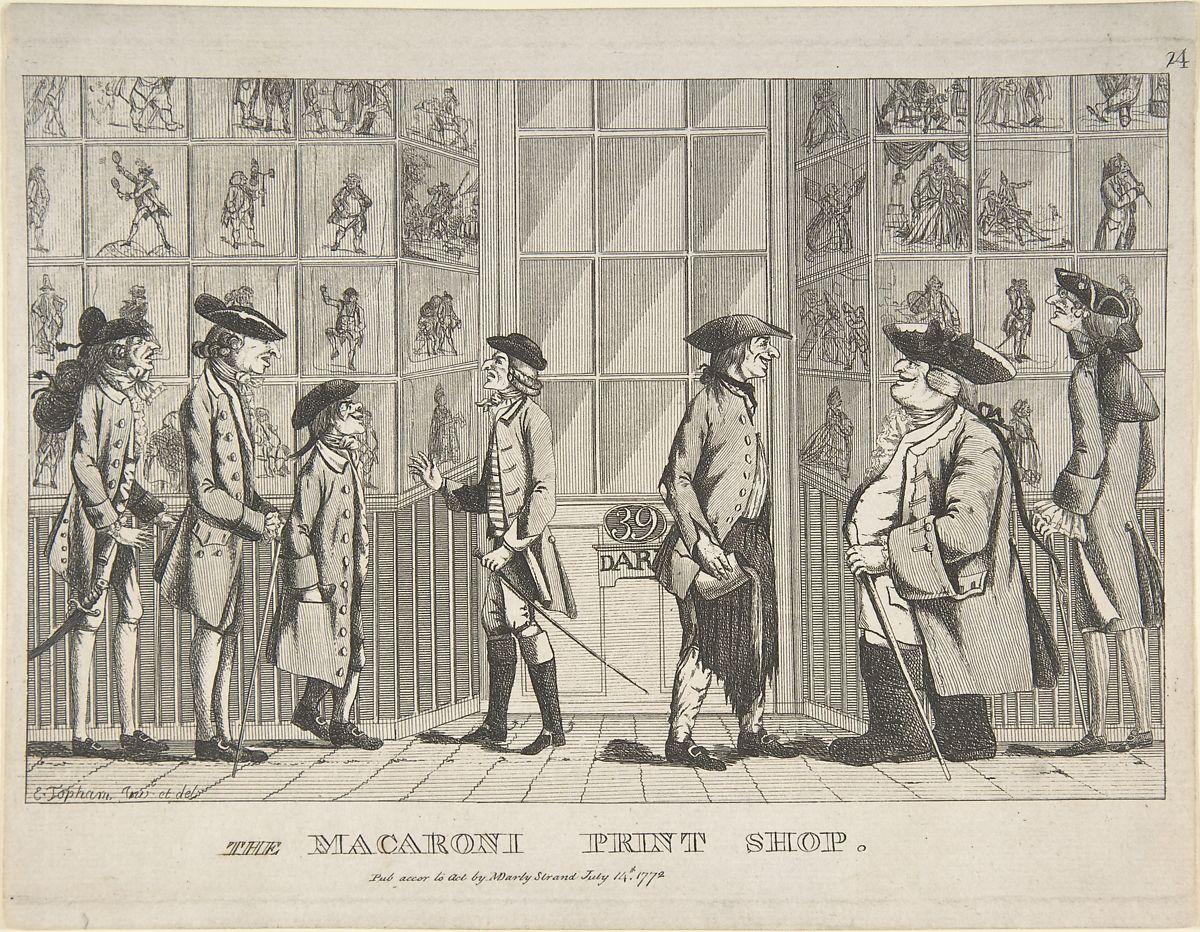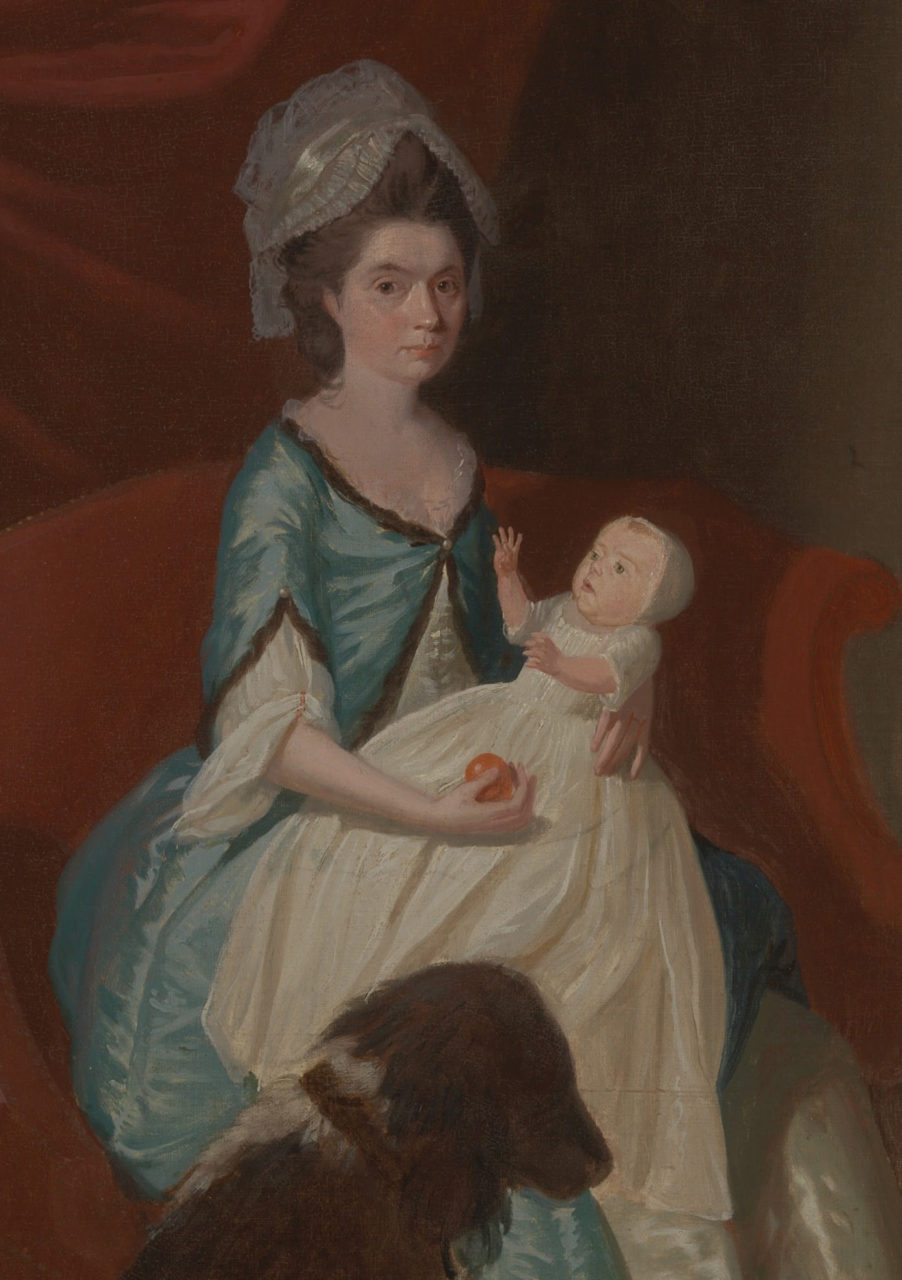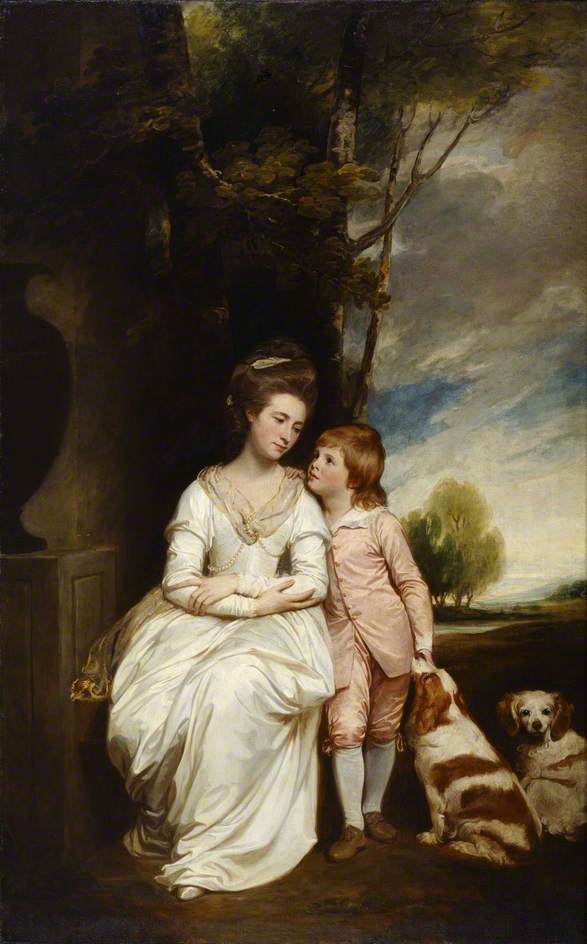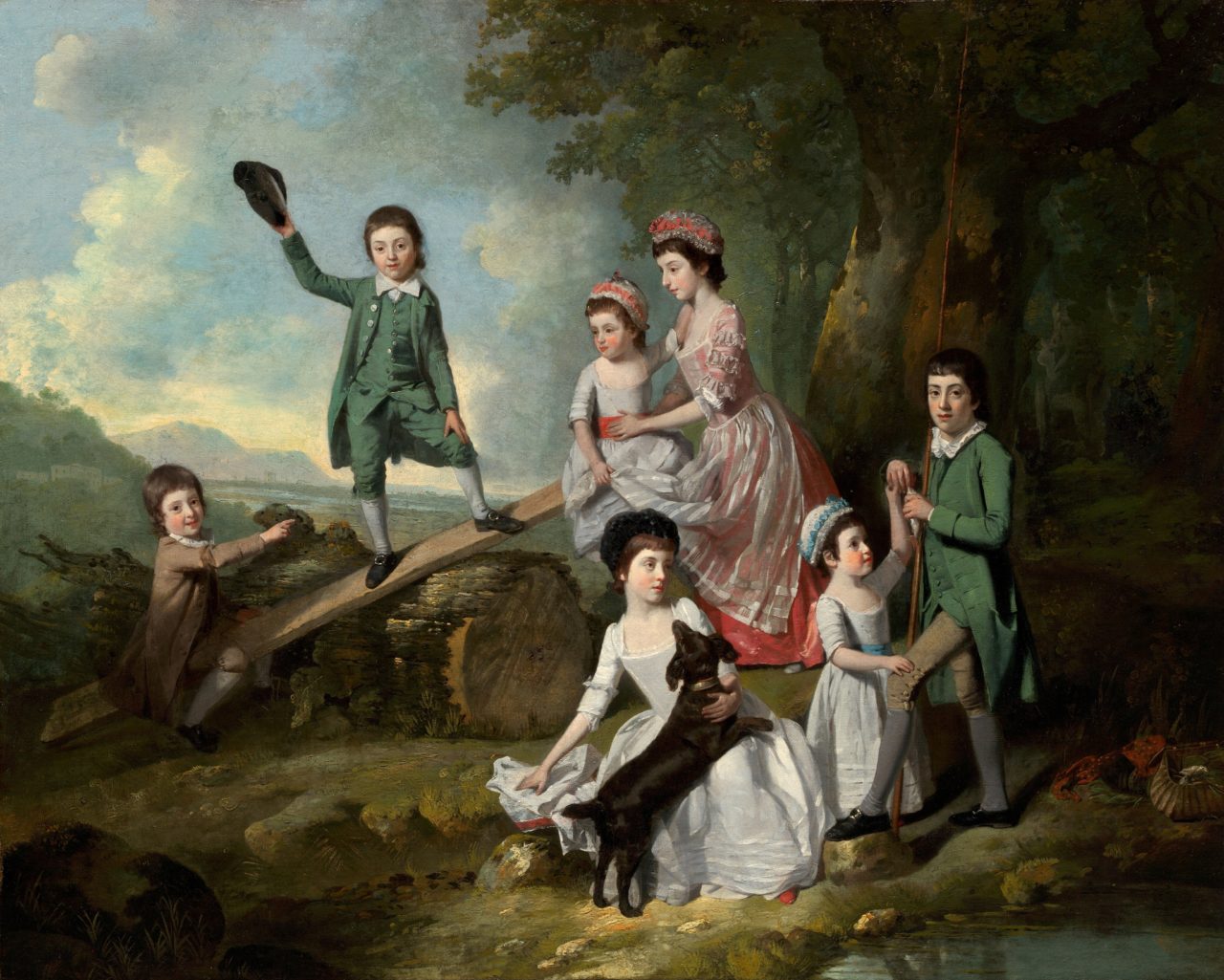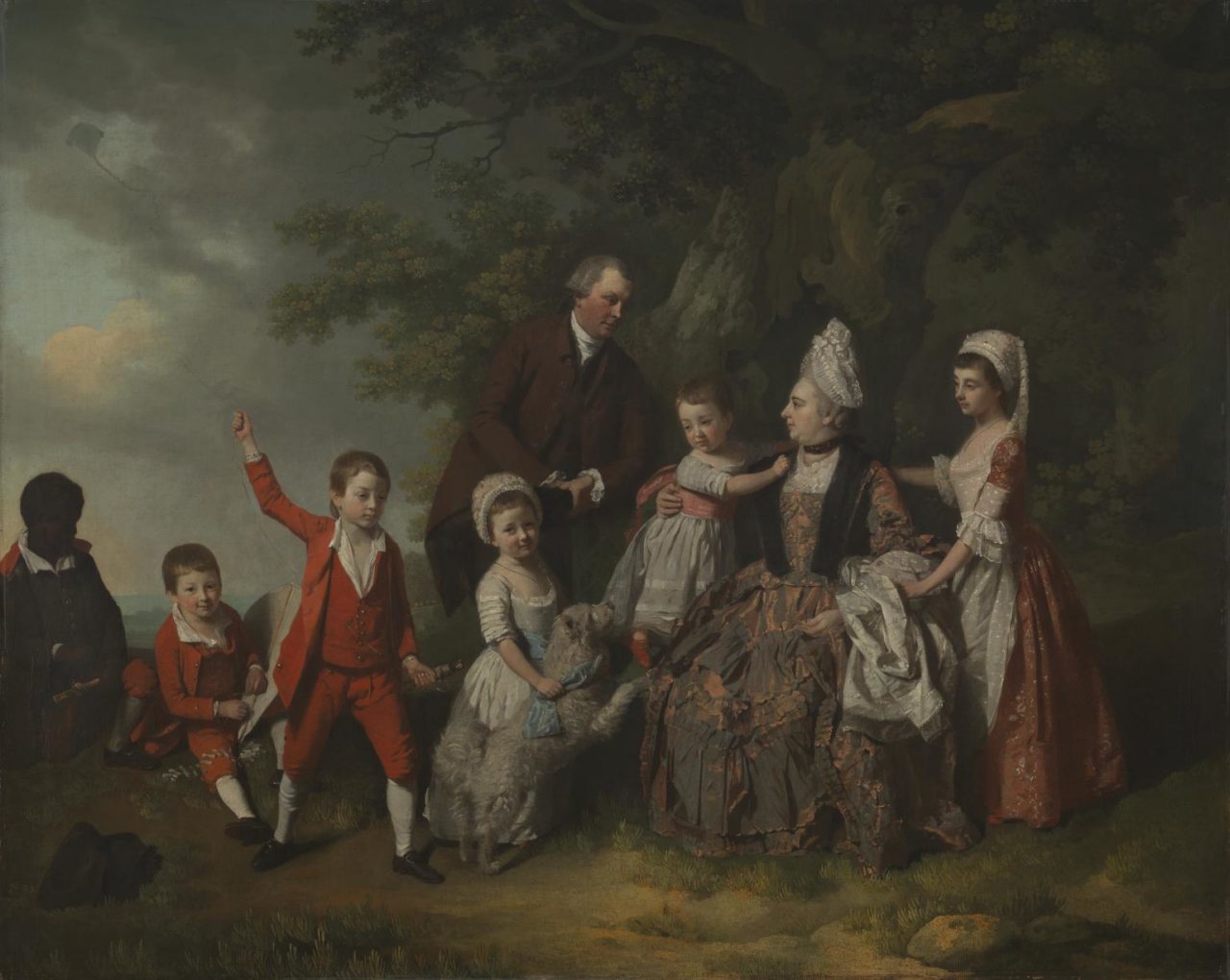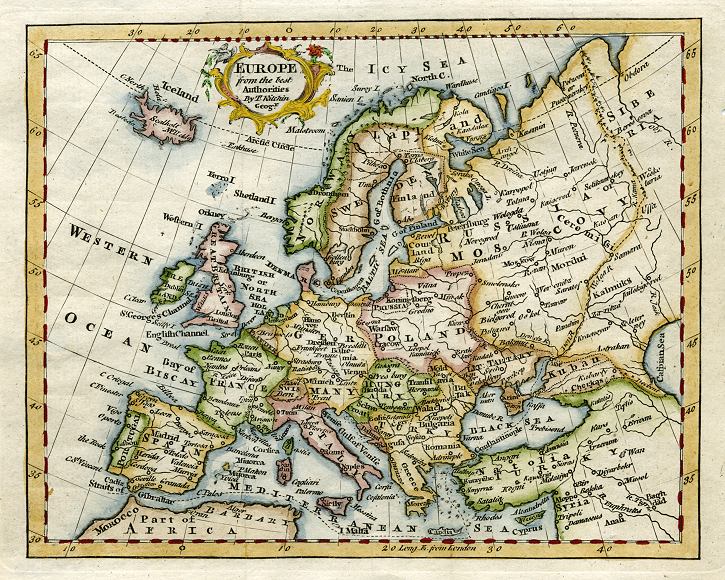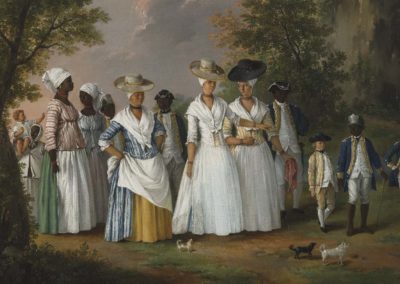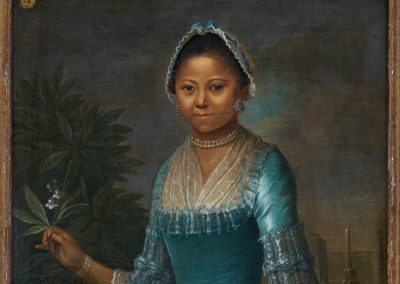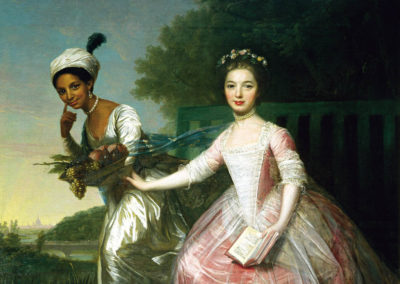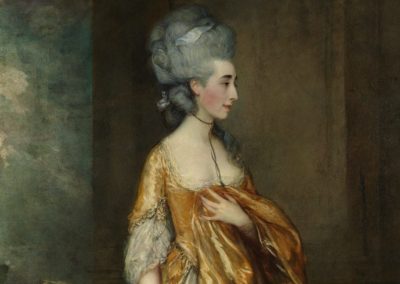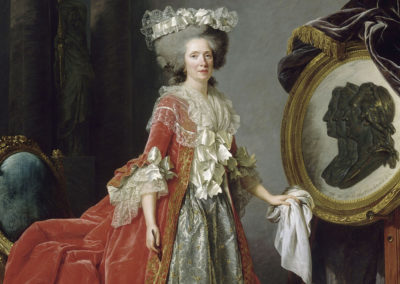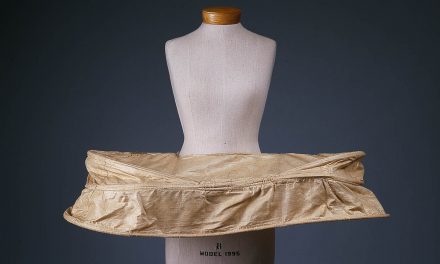OVERVIEW
1770s fashion simplified the earlier decades styles for both womenswear and menswear, leading to new fashions that exemplified the ‘casual’ aesthetic that had taken hold.
The 1770s marked a transition in men’s and women’s dress, particularly for daywear. The growing popularity of what had previously been considered informal styles along with the increasing use of wool, cotton, and plain, lightweight silks changed the look of masculine and feminine attire towards greater simplicity. For men, the overall line of the three-piece suit became slimmer with the coat skirts cut well away from the center front, tight-fitting sleeves, and narrow tails. For women, the robe à la française with its characteristic box pleats falling from the back shoulders to the hem gave way to the robe à l’anglaise with a fitted bodice, the robe à la polonaise, and the caraco, or jacket bodice, and petticoat combination.
Womenswear
In this decade, the generously trimmed robe à la française, or sack, ceded its decades-long dominance to other styles and was primarily worn for formal wear (Figs. 1 & 2). At the same time, the hoop, which had given the robe à la française its distinctive shape, “disappeared except for court” and was replaced by “small paniers, or hip pads” (Ribeiro 222). The fitted gown, known in France as the robe à l’anglaise, had been worn in England throughout the century, alongside the sack as a more informal garment, and “in the 1770s, it had a new lease of life with a closed front opening” that obviated the need for a separate stomacher (Ribeiro 222) (Figs. 3 & 4). Initially, the back panels of this gown were stitched down as far as the waist and continued into the skirt; by the 1780s the bodice and skirt would be cut separately (Ribeiro 222). The oval-shaped sleeve ruffles accessorized with lace engageantes that had been standard since the 1740s were replaced by ruched cuffs, called “sabots” in French, of self-fabric, muslin, or gauze that fitted closely around the elbow (Figs. 3-6). Like the robe à la française, the robe à l’anglaise was worn over a matching or contrasting petticoat (Figs. 3 & 4).
One of the most popular styles from the mid-1770s to the mid-1780s was the robe à la polonaise (Fig. 6). Dress historians Kendra Van Cleave and Brooke Welborn have charted the appearance of this two-piece gown in contemporary fashion periodicals and other publications, including fifty-nine plates in the Galerie des Modes that illustrate the robe (full-length), carcao (hip-length jacket), and camisole (short jacket) à la polonaise (Van Cleave and Welborn 2). As they note, in addition to the distinctive swags created by looping up the skirt with interior ribbons or cords that were “attached on the outside of the gown at or below the waist,” the polonaise “was in fact equally distinguished by the cut of the robe” with two front and two back pieces “cut without a waist seam” (Van Cleave and Welborn 4-5) (Figs. 6 & 7). While the petticoat of the robe à la française and the robe à l’anglaise was only decorated across the front opening where it was visible, the exposed hem of the polonaise petticoat was fully trimmed (Figs. 6 & 7).
Fig. 1 - Designer unknown (French). Robe à la française of brocaded silk, ca. 1775. Silk. New York: The Metropolitan Museum of Art, 2005.61a, b. Isabel Shults Fund, 2005. Source: The Met
Fig. 2 - Designer unknown (French). Robe à la française of brocaded silk (back), ca. 1775. Silk. New York: The Metropolitan Museum of Art, 2005.61a, b. Isabel Shults Fund, 2005. Source: The Met
Fig. 3 - Nicolas Dupin (French, c. 1753-1791). Robe à l’anglaise of green “Pekin” (silk) trimmed with Italian gauze and a “Pouf” or Italian gauze edged with flowers; pink shoes and white rosette, ca. 1778. Paris: National Library of France. Source: BnF Gallica
Fig. 4 - Designer unknown (British). Robe à l'Anglaise, ca. 1770. Silk. New York: The Metropolitan Museum of Art, 2018.111a, b. Purchase, Irene Lewisohn Bequest, 2018. Source: The Met
Fig. 4 - Designer unknown (British). Robe à l'Anglaise (back), ca. 1770. Silk. New York: The Metropolitan Museum of Art, 2018.111a, b. Purchase, Irene Lewisohn Bequest, 2018. Source: The Met
Fig. 5 - Maker unknown (probably French). Cuffs, 1770s. Silk. New York: The Metropolitan Museum of Art, 1992.310a, b. Purchase, Judith and Gerson Leiber Fund, 1992. Source: The Met
Fig. 6 - Nicolas Dupin (French, c. 1753-1791). Robe à la polonaise, ca. 1778. Paris: National Library of France. Source: BnF Gallica
Other informal styles included the lévite, the circassienne, and the caraco and petticoat. The first of these was a kind of wrapping gown tied around the waist with a sash that was named after the costumes worn “by actresses playing the Jewish priests” in a production of Racine’s play, Athalie (Ribeiro 228) (Fig. 8). Writing in 1779, Horace Walpole expostulated on Lady Ossory’s “glorious figure” concealed by what he referred to as a “hop-sack:” “where the deuce is the grace of a man’s nightgown bound round with a belt?” (quoted in Ribeiro 228). The circassienne “incorporated elements of the oriental…sometimes with a polonaise skirt and short sleeves trimmed with fur and decorated with tassels;” according to the Galerie des Modes, published between 1778 and 1787, the name derived “from the grand Sultan’s favourites in the seraglio” (Ribeiro 228, 270) (Fig. 9). Although the caraco-and-petticoat ensemble that derived from working-class dress had been worn by elite women in the privacy of the home or for country pursuits since the early decades of the eighteenth century, it now became acceptable for fashionable daywear in urban settings, fabricated in lightweight silks or increasingly available printed cottons (Figs. 10-12). As with the polonaise, the petticoat was often trimmed around the hem (Figs. 10 & 11).
Fig. 7 - Jean Michel le-Jeune Moreau (French, 1741-1814). Le Rendez-vous pour Marly, from Monument du Costume Physique et Moral de la fin du dix-huitieme siecle ou Tableaux de la vie, 1777. Smith College Museum of Art, SC 1964:24-9. Purchased with the gift of Mrs. Charles Lincoln Taylor. Source: Artstor
Fig. 8 - Pierre Adrien Le Beau (French, b. 1748). Robe à la lévite, 1779. Engraving. New York: BGC Visual Media Resources Collection, 216179. Source: Pinterest
Fig. 9 - Nicolas Dupin (French). Page from Gallerie des modes et costumes français, 1778-1787. Engraving; 23 x 16 cm. Paris: National Library of France. Source: BnF Gallica
Fig. 10 - Nicolas Dupin (French). Pouf in the Gallerie des Modes, 1778-1787. Engraving; 23 x 16 cm. Paris: National Library of France. Source: BnF Gallica
Fig. 11 - Designer unknown (French). Dress, ca. 1778. Silk. New York: The Metropolitan Museum of Art, C.I.37.57a, b. Gift of Irene Lewisohn, 1937. Source: The Met
Briefly popular in the mid-1770s was the robe à la piétmontaise (Fig. 13). Illustrated in the Galerie des Modes in 1778, which situated its origin “at the theatre of Lyon during the sojourn of Her Royal Highness Madame Clotilde of France, Princess of Piedmont [sister of Louis XVI], in 1775” (quoted in DeGregorio/Cora Ginsburg 25), this hybrid dress was:
“an idiosyncratic mediation between the body-conscious robe à l’anglaise… and the fluid robe à la française.” (DeGregorio 25)
In an example of this style made from a Chinese export silk, the skirt can be pulled up into swags à la polonaise with two silk ribbon loops that attach to covered buttons at the back waist (Fig. 14). Many surviving robes à l’anglaise also have inner tapes or loops to achieve the same effect.
Fig. 12 - Designer unknown (English). Caraco and Petticoat, ca. 1770-1780. Cotton, painted and dyed. London: Victoria and Albert Museum, T.229&A-1927. Given by Sir Luke Fildes KC. Source: V&A
Fig. 13 - Designer unknown (French). Robe à la Piétmontaise, ca. 1775-80. Chinese silk. Source: Cora Ginsburg
Fig. 14 - Designer unknown (French). Robe à la Piétmontaise Detail, ca. 1775-80. Chinese silk. Source: Cora Ginsburg
As earlier in the century, outerwear for women consisted of capes and cloaks (sometimes with a hood) that accommodated their full-silhouetted garments. A 1779 plate from the Galerie des Modes illustrates a bourgoise aisée (well-off bourgeoise) in a three-quarter length blue silk pelisse—a hooded cloak with armholes—trimmed with ermine and carrying a white fur muff (Fig. 15)
Many of the above-mentioned styles are illustrated in the Galerie des Modes et costumes français, one of the first regular fashion publications that emerged in the last quarter of the eighteenth century, signaling the beginnings of an established fashion press (Fig. 16). The large-format black-and-white or hand-colored images depict single male or (primarily) female figures (and, occasionally, a couple) in the latest styles. The captions highlight the importance of terminology in the identification of fashion novelties that often referred to topical events. In addition to frequently used descriptors such as à l’anglaise or à la polonaise, the Galerie’s publishers assumed a familiarity with more fleeting trends, especially those that influenced coiffures, headwear, and trimmings.
For formal occasions at the French court and elsewhere on the Continent, the grand habit comprising a heavily boned bodice, full-length petticoat, and long train was still required. Although Marie Antoinette disliked this antiquated and restrictive ceremonial dress and preferred more informal styles, her status as Queen of France obliged her don the grand habit as seen in many of her portraits (Fig. 17). A fashion plate from the Galerie des Modes from 1778 illustrates the queen in an “habit de cour” of cherry-red satin extensively trimmed with bands of lace worn over a wide pannier, a green silk train, and white plumes, red ribbon, and a diamond spray decorating her high coiffure (Fig. 18). The cloth-of-silver dress worn by Edwige Elisabeth Charlotte de Holstein-Gottorp for her marriage to Prince Karl of Sweden in 1774 illustrates the richness and impressive dimensions of these gowns that were intended to communicate royal splendor (Figs. 19 & 20).
Along with the introduction of informal styles for daywear were changes in fashionable textiles. The heavy, brocaded, lushly floral silks of the mid-century were superseded by silks that were both lighter in weight and simpler in design, heralding “the advent of Neo-Classicism” (Rothstein 54). In the first half of the 1770s, motifs shrank significantly and “the vertical element of the late 1760s proliferated in the early 1770s into clusters of broad and narrow stripes” (Rothstein 54) (Fig. 1). By the middle of the decade, “the clustered stripes had all but disappeared and, instead…[they were] absolutely regular in width.” (Rothstein 55).
Fig. 15 - Nicolas Dupin (French). Pelisse from Galerie des Modes, 1779. Engraving. Paris: National Library of France. Source: BnF Gallica
Fig. 16 - Nicolas Dupin (French). Title Page of Galerie des Modes, ca. 1778-1787. Engraving. Paris: National Library of France. Source: BnF Gallica
Fig. 17 - Jean Baptiste André Gautier d'Agoty (French, 1740-1786). Marie Antionette in Court Clothes with her Hand on a Globe, 1775. Oil on canvas; 160 x 128 cm. Paris: Grand Palais, MV 8061. Source: Vogue
Fig. 18 - Artist unknown (French). Page from Galerie des Modes, 1778. Engraving. Source: University of Washington
Fig. 19 - Designer unknown (Swedish). Wedding gown of Edwidge Elisabeth Charlotte Holstein-Gottorp, wife of Prince Karl and sister-in-law of King Gustav III of Sweden, 1774. Stockholm: Royal Armoury. Source: Guardian
Fig. 20 - Alexander Roslin (Swedish, 1718-1793). Portrait of Hedwig Elizabeth Charlotte of Holstein-Gottorp, 1775. Oil on canvas; 100 x 130 cm. Stockholm: National Museum of Fine Arts. Source: Wiki
Fig. 21 - Designer unknown (French). Robe à la Française, ca. 1770s. White linen chinz with blue plant motif. Kyoto: Kyoto Costume Institute, AC7621 92-34-2AB. Source: KCI
Fig. 22 - Nicolas Dupin (French). Page from Galerie des Modes, ca. 1778. Engraving. Paris: National Library of France. Source: BnF Gallica
Samples from the pattern book of the Spitalfields (London) firm Batchelor, Ham and Perigal from these years illustrate the vogue for small, stylized sprigs combined with stripes (see Rothstein, plates 305-310). The Chinese silk used to fabricate the robe à la Piétmontaise “mimick[s] contemporary French taffetas called mexicaines” (DeGregorio 26) (Figs. 13 & 14). Nonetheless, given the inherent value of expensive textiles, silk gowns were regularly re-made in the eighteenth century; the crimson red lace-patterned silk damask of the robe à l’anglaise in the collection of the Costume Institute dates to the 1720s (Figs. 4-5).
In the last quarter of the century, men and women across the socio-economic spectrum in Britain and France increasingly incorporated plain and printed cotton and linen garments and accessories into their wardrobes. Following the lifting of the bans in Britain (1774) and France (1759) that had prohibited both the importation of Indian cottons as well as domestic production since the late seventeenth and early eighteenth centuries, manufacturers in both countries offered a range of these textiles that targeted upper-, middle- and working-class consumers (Fig. 21). Barbara Johnson’s album of fabric swatches documenting her wardrobe purchases over seven decades attests to the larger shift from silk to cotton and linen in the last decades of the century. In the 1770s, she purchased a blue-and-white checked cotton to make up a Brunswick (a traveling costume comprising a thigh-length hooded jacket with tight wrist-length sleeves and a decorative ruffle at the elbow); “yellow spotted linnen” and “purple and white” linen for two gowns; and floral chintzes (cottons) for two additional gowns. While the checked cotton was woven, the linens and chintzes were block printed and all were undoubtedly of British manufacture (Rothstein/Barbara Johnson’s Album of Fashion and Fabrics, n.p.). A 1778 plate from the Galerie des Modes showing a young woman in a cotton robe à la Polonaise with a blue-and-white vermicelli pattern and matching petticoat with floral-patterned bands (likely of French manufacture) illustrates the use of this fabric for the new, informal styles (Fig. 22). For affluent consumers, expensive Indian hand-painted-and-dyed cottons were still in demand, as seen in the caraco and petticoat from the Victoria & Albert Museum (Fig. 12). However, the wearer of a rare surviving robe à la française and matching petticoat, dating to about 1775, selected a high-end block-printed French cotton for her gown that accommodates wide panniers, making it suitable for a formal event (Cora Ginsburg 2019, 2-5) (Fig. 23).
Although informal styles were the order of the day in the 1770s, understructure was still necessary to give them—and the female body itself—the correct shape. Small paniers or pocket hoops (a pair of small hoops worn over each hip) replaced the large paniers that had created the distinctive female silhouette since the 1720s (Fig. 24). In addition to these, cork-filled supports, called “rumps,” were also worn. In 1776, a poem published in The Universal Magazine satirized the contemporary fashion victim:
“Let her gown be tucked up to the hip on each side, shoes too high for to walk or jump, and to deck the sweet creature complete for a bride, let the cork-cutter make her a rump.” (quoted in Cunnington/Underclothes 91; Fig. 25)
The boned corset, or stays, remained a key foundation garment (Fig. 24). From the 1760s, additional boning inserted across the bust exaggerated its roundness (Waugh/Corsets and Crinolines 41). A suggestive plate from the Galerie des Modes (1778) hints at the potentially improper access that the staymaker had to women’s bodies (Fig. 26). Under her yellow batiste corset with blue ribbon lacing at the center front and back, the client—seemingly oblivious to the gaze of the staymaker directed at her cleavage—wears a white linen calf-length chemise that was the primary undergarment for women of all classes throughout the century. In its extended description of this plate, the Galerie des Modes distinguishes between the “corps piqué, ou corps de baleine” that the young woman wears and the “corset” that was “plus flexible.” Towards the end of the century, this more lightly boned, or half-boned, corset was more often worn under daywear.
Shoes of the 1770s with high curved heels and pointed toes were clearly visible under the short petticoats of the robe à la polonaise and the caraco ensemble. At the end of the 1760s, “the slender ‘Italian’ heel with its wedge-like extension under the instep” gained in favour” [and] “the delicate form of the shoe would have accentuated the shapeliness of the leg” (Pratt and Woolley 49) (Fig. 27). Although buckles that secured the latchets over the instep were still worn, the Galerie des Modes illustrates shoes decorated with fabric rosettes (Fig. 3). In another 1778 plate from the Galerie des Modes, a young woman looks out coyly from under the brim of her plumed hat as she fastens a pink silk garter around “her beautiful leg” covered in a white silk stocking; her pink silk shoe matches the pink striped taffeta of her gauze-trimmed robe à la polonaise (Fig. 27). A pair of red silk shoes that accompanied the French block-printed cotton robe à la française indicates that these accessories might have coordinated with, but did not necessarily match, the gown with which they were worn (Figs. 23 & 28).
Fig. 23 - Designer unknown (probably French). Robe à la Française, ca. 1770-1775. Block-printed cotton. Source: Cora Ginsburg
Fig. 24 - Designer unknown. Pannier, ca. 1775. Cotton chintz with oval rattan hoops and padding. Kyoto: Kyoto Costume Institute, AC7682 93-1-4. Source: KCI
Fig. 25 - Matthew Darly (English, c. 1720-1780). Satirical Print, 1777. Hand-colored engraving. London: The British Museum, J,5.129. 1818, donated by Dorothea, Lady Banks. Source: The British Museum
Fig. 26 - Pierre-Thomas LeClerc (French, c. 1740-1799). Tailleur Costumer Essayant Un Cor A La Mode, 1778. Engraving. Boston: Museum of Fine Arts Boston, 44.1356. The Elizabeth Day McCormick Collection. Source: MFA
Fig. 27 - Pierre-Thomas LeClerc (French, c. 1740-1799). Femme en Robe à la Polonaise, 1778. Engraving. Boston: Museum of Fine Arts Boston, 44.1296. The Elizabeth Day McCormick Collection. Source: MFA
Fig. 28 - Designer unknown. Shoes, 1770s. Photograph by Michael Fredericks. Source: Cora Ginsburg
Fig. 29 - Thomas Gainsborough (British, c. 1727-1788). Mrs. Grace Dalrymple Elliott, 1778. Oil on canvas. New York: The Metropolitan Museum of Art, 20.155.1. Bequest of William K. Vanderbilt, 1920. Source: The Met
The increasing height of women’s coiffures in the mid-to-late 1760s reached extravagant proportions in the following decade. Recorded in both portraits and innumerable caricatures, these towering tonsorial creations involved the use of a pad, false hair, pomatum, and powder (Fig. 29). In Fanny Burney’s 1778 epistolary novel Evelina, the eponymous heroine, a beautiful young girl of sixteen who has lived a sheltered life in the countryside, is introduced to the complexities of London society with its many possibilities for faux pas. On her first visit to the English capital, she describes to her guardian the various transformations that “Londonize” her, including her strange new hairstyle:
“I have just had my hair dressed. You can’t think how oddly my head feels; full of powder and black pins, and a great cushion on the top of it. I believe you would hardly know me, for my face looks quite different to what it did before my hair was dressed. When I shall be able to make use of a comb for myself, I cannot tell, for my hair is so much entangled, frizled they call it, that I fear it will be very difficult.” (Burney 27-28)
To this mass of hair, the coiffeur added all manner of artificial flowers, fruits, foliage, and other decorations known as a “pouf.” The rage for novelty that increasingly characterized fashion during the last quarter of the century is evident in the names of these themed concoctions (Fig. 30). The coiffure “à l’Indépendance ou le Triomphe de la liberté” that celebrated the destruction of a Royal Navy vessel by the French frigate at the Battle of Ushant on July 27, 1778, shortly after France signed a “treaty of alliance with the United States,” featured a fully rigged model ship atop the wearer’s head (Campbell 160) (Fig. 31). Not surprisingly, British caricatures made plain that the origin of these flamboyant structures—and the mishaps that could ensue from their impracticality—was France; however, they were, in fact, satirized on both sides of the Channel (Fig. 32).
Fig. 30 - Matthew Darly (British, c. 1756-1779). The Extravaganza, 1776. Engraving; 34.0 x 23.5 cm. Source: Invaluable
Fig. 31 - Artist unknown (French). Hairstyle to Independence, ca. 1778. Engraving. Paris: RMN Grand Palais, CFAc272. Source: L'Agence Photo
Fig. 32 - Samuel Hieronymus Grimm (British, 1733-1794). The French Lady in London, 1771. Engraving. London: The British Museum, J,5.111. 1818, donated by Dorothea, Lady Banks. Source: The British Museum
Time consuming to assemble, these elaborate hairstyles remained in situ on the head for an extended period of time. To protect their coiffeurs’ hard work, women covered their hair at night with large caps and slept propped up on pillows. Out of doors, against inclement weather, they availed themselves of a calash, or calèche, a large collapsible hood with cane insertions named after a small carriage with a folding top (Cunnington 350) (Figs. 33 & 34).
SEEING AND BEING SEEN
Throughout the century, members of elite society frequented indoor and outdoor spaces where they could see and be seen by their peers and others. The theatre was one of the key places for this kind of socializing and, in London, in particular, pleasure gardens were a feature of social life during the “season.” In her first letters to her guardian from London, Evelina cites the Opera House, Drury Lane theatre, Ranelagh (a pleasure garden located in the Chelsea area), and the Pantheon (a concert and assembly hall in Oxford Street)—all fashionable venues that she soon visits (Burney 24-25). From her home in Buckinghamshire, Barbara Johnson kept abreast of current styles and popular arenas of display through the emerging fashion press; on the same page with the “yellow spotted linnen” that she purchased in 1776, Johnson pasted an engraving from The Ladies Pocket Book “with a View of the Company” at both Ranelagh and the Pantheon (Fig. 35).
Fig. 33 - W. Richardson (British). Satirical Print Titled "Miss Calash, Drawn by Miss Calash", Oct 14th, 1778. Engraving. New York: BGC Visual Media Resources Collection, 248575. Source: Art.com
Fig. 34 - Designer unknown (probably American). Calash, 18th century. Silk. New York: The Metropolitan Museum of Art, C.I.45.68.44. Gift of Art Worker's Club, 1945. Source: The Met
Fig. 35 - Compiler: Barbara Johnson (British, 1738-1825). Page from Barbara Johnson’s album of fashion, 1776. London: Victoria and Albert Museum, T.219-1973. Source: V&A
Fig. 36 - After Thomas Rowlandson (British, 1757-1827). Vauxhall Gardens, 1785. Hand-colored etching with aquatint; 50.5 x 75.5 cm. London: The British Museum, 1880,1113.5484. Source: British Museum
During one of Evelina’s outings to Drury Lane theatre, the foppish Mr. Lovel,
“confess[es] that he “seldom listen[s] to the players: one has so much to do, in looking about, and finding out one’s acquaintance, that, really, one has no time to mind the stage” and that, in fact, he has no idea what play he has come to see since “one merely comes to meet one’s friends, and shew that one’s alive.” (Burney 80)
Another incident in the novel reveals that dressing for the theatre was dictated, in part, by where one sat. Evelina’s unexpected excursion to the opera with her middle-class cousins reveals their unfamiliarity with this etiquette and her snobbish surprise at their ignorance that “the pit at the opera required the same [formal] dress as in the boxes” (Burney 85). Seated in the upper reaches of the cheaper gallery and attired in a formal gown and conspicuous coiffure rather than the informal hats worn by her female relatives, Evelina subsequently acknowledges that she was “a little uneasy at finding that my dress, so different from that of the company to which I belonged, attracted general notice and observation” (Burney 89). In fact, one of her many suitors, Sir Clement Willoughby, recognizes her “high and distant as [she] was from him” by her head-dress (Burney 92).
Fig. 37 - Thomas Gainsborough (British, c. 1727-1788). The Mall in St. James’s Park, ca. 1783. Oil on canvas; 120.7 x 147 cm. New York: The Frick Collection, 1916.1.62. Henry Clay Frick Bequest. Source: The Frick
During the warm summer months, parks—like St. James’s in London and the Tuileries in Paris—and pleasure gardens were popular meeting grounds (Fig. 36). London’s many gardens attracted visitors from all classes, who enjoyed their natural attractions as well as entertainments such as concerts and nightly illuminations (Wroth/The London Pleasure Gardens of the Eighteenth Century) (Fig. 37). During her first week in that city, Evelina, her host, Mrs. Mirvan, and her daughter, Miss Mirvan, join the many promenaders in the Mall in St. James’s Park (Fig. 37).
Although the “long straight walk, of dirty gravel” hardly lives up to Evelina’s expectations, she observes that “every body looked gay, and seemed pleased, and the ladies were so much dressed, that Miss Mirvan and I could do nothing but look at them. Mrs. Mirvan met several of her friends. No wonder, for I never saw so many people assembled together before… all the world seemed to be there.” (Burney 26-27)
After an outing to Ranelagh—“some inchanted castle, or fairy palace”—Evelina comments on the “crowded” room of the Rotunda, the garden’s main architectural attraction and the procurement of a box, “which is the name given to the arched recesses which are appropriated for tea parties,” by Sir Clement Willoughby (Burney 37, 58) (Fig. 38). Some of Mrs. Mirvan’s female acquaintances invite her to “take a round” with them, that is, to circumnavigate the large central stove (Burney 58). Whether seated or strolling in these outdoor venues, men and women “of quality” put themselves on display for their own benefit and that of others.
Fig. 38 - Canatello (Italian, 1697-1768). Interior of the Rotunda at Ranelagh, 1754. Oil on canvas; 47 x 75.6 cm. London: The National Gallery, NG1429. bought 1894. Source: National Gallery
Fashion Icon: Marie Antoinette, Queen of France (1755-1793)
The decade’s undisputed fashion icon was Queen Marie Antoinette, whose style choices were closely followed and copied by other women at the court of Versailles and beyond (Fig. 1). Although the queen’s relentless and inordinately expensive pursuit of fashion, which regularly exceeded her annual budget allowance of 120,000 livres, contributed heavily to her eventual downfall, she was an acknowledged trendsetter from the mid-1770s (following Louis XVI’s accession to the throne in 1774) to the early 1780s (Ribeiro 183). Every winter and summer, the queen ordered:
“twelve grands habits, twelve robes parées (formal robes with paniers) and twelve undress robes, all of which were discarded at the end of the season” in addition to “informal muslin or linen gowns that were bought when required” (Ribeiro 183). Yet, this generous renewal of her wardrobe was insufficient for the fashion-obsessed queen and, “in one year alone 172 new gowns were ordered” (Ribeiro 184).
Fig. 1 - Élisabeth Louise Vigée Le Brun (French, 1755-1842). Marie-Antoinette, 1783. Oil on canvas. Washington, DC: NGA, 1960.6.41. Timken Collection. Source: NGA
In her desire to be the most à la mode woman in France—a status that was completely at odds with the piety and modesty expected of the king’s wife—Marie Antoinette was aided and abetted by her savvy milliner-enabler, the renowned Rose Bertin, who parlayed her close relationship with the queen into a highly successful enterprise that catered to French and international aristocratic clients (Chrisman-Campbell 25-31) (Fig. 2). By the early 1780s, Bertin was dismissively referred to as Marie Antoinette’s “Minister of Fashion” and “Minister of Trinkets” and, in 1787, the year that Marie Antoinette determined to cut back on her astronomical wardrobe expenditures, she was dubbed “Madame Deficit” (Weber 123, 183).
Fig. 2 - Jean François Janinet (French, 1752–1814). Mademoiselle Rose Bertin, Dressmaker to Marie-Antoinette, ca. 1780. Etching; 11.6 × 9.9 cm. New York: The Metropolitan Museum of Art, 24.80.141. Anonymous Gift, 1924. Source: The Met
Fig. 3 - Elisabeth Louise Vigée Le Brun (French, 1755–1842). Marie Antoinette in Court dress, 1778. Oil on canvas; 273 × 193.5 cm. New York: The Metropolitan Museum of Art. Kunsthistorisches Museum, Vienna, Gemäldegalerie (GG 2772). Source: The Met
Fig. 4 - Artist unknown (French). Marie Antionette in a Redingote, ca. 1780. New York: BGC Visual Media Resources Collection, 214248. Source: Fashion Muse
Fig. 5 - Artist unknown (French). Page 41 from Fabric Swatch Book for the Wardrobe of Marie Antoinette, 1782. New York: BGC Visual Media Resources Collection, 214439. Source: Rodama
Fig. 6 - Elisabeth Louise Vigée Le Brun (French, 1755–1842). Marie Antoinette with a Rose, 1783. Oil on canvas; 116.8 × 88.9 cm. New York: The Metropolitan Museum of Art. Lynda and Stewart Resnick. Source: The Met
In the mid-1770s, Marie Antoinette’s extravagant adoption of the “pouf” demonstrated the young queen’s interest in and success at setting current fashions (Fig. 3). As historian Caroline Weber has noted, the queen’s partiality for the “pouf” further popularized these outsized coiffures whose “topical messages… allowed her to play at politics and look fashionable” (Weber 107). While many Parisian women copied the queen’s “self-promoting coiffures,” her mother, Empress Maria Theresa of Austria, was unimpressed (Weber 106). In his Mémoires Secrets, Bachaumont recounted in 1775 that,
“The Queen sent the Empress her mother her portrait shewing her new style of dress, that is to say, her head ornamented with many high feathers. It is said that this august sovereign returned it to her saying that there must be some mistake as she had received a portrait, not of the Queen of France, but of an actress.” (quoted in Waugh/Women 120)
Marie Antoinette wholeheartedly adopted informal styles such as the the lévite (which she wore during her first pregnancy in 1778), the robe à l’anglaise, the redingote (a coat-dress with a large turned-down collar and lapels inspired by menswear; Fig. 4), and the robe à la turque (Ribeiro 228). The Gazette des Atours, an album with swatches of the queen’s dress fabrics dating to 1782, includes numerous examples of plain, striped, and small-patterned taffetas (Fig. 5) that were used to make all of these gowns as well as the formal grand habit and dresses to be worn with a “grand panier” or a “petit panier” (Gazette des Atours de Marie Antoinette, n. p.).
Undoubtedly the informal gown most closely associated with Marie Antoinette and her rejection of formal court dress is the chemise, that came to be known as the chemise à la reine and that she may have initially worn “during her second pregnancy in 1781” (Chrisman-Campbell 172, 180). In 1783, the queen’s favorite portraitist, Elisabeth Vigée-Lebrun, who had already recorded Marie Antoinette in the grand habit in 1778 and 1780, depicted the royal consort in this shockingly simple one-piece white muslin gown (Fig. 1). The backlash against this image of the increasingly unpopular queen, against whom the tide of public opinion had resolutely turned, resulted in the withdrawal of the painting from the Salon of 1784 and its replacement by a more acceptable portrayal of Marie Antoinette by the same artist in a lace-trimmed blue silk robe à l’anglaise. (Fig. 6). Not only was it deemed unseemly for the queen to be represented in such an informal gown that she was known to wear for her playacting bucolic lifestyle at the Petit Trianon, her private retreat on the grounds of Versailles, her choice of cotton, rather than Lyonnais silk, was castigated as a deliberate and offensive repudiation of this French luxury commodity. However, many women—including those of the elite classes— wore white cotton chemises in the 1780s and this unadorned garment would become the fashionable gown of the turn of the nineteenth century.
On October 16, 1793, as ordered by the Revolutionary Tribunal, Marie Antoinette removed the black widow’s weeds that she had worn since the execution of her husband in January and mounted the scaffold in an all-white cotton ensemble that she had deliberately set aside, becoming “a figure of pure, radiant white’ (Weber 287) (Fig. 7). As her recent biographer Caroline Weber argues, this “outfit may have been the most brilliant fashion statement of her entire career” (Weber 287). Marie Antoinette well understood the power and symbolism of dress and throughout her tenure as queen, her sartorial choices, while ultra-modish, also conveyed carefully calculated messages to those around her. Although her stripped-down appearance on that day “erased” the formerly bejeweled, befeathered, and beribboned queen, her white garments also suggested “her perilously fashionable past” through their evocation of the color of “the fleur-de-lys…a powdered head…a muslin gaulle…ostrich feathers…[and] the monarchist cockade that launched the march on Versailles” (Weber 288). Ironically, however, the last view that her former subjects had of their despised queen was in a style of dress that fully accorded with Republican sartorial ideals of simplicity, transparency, and virtue.
Fig. 7 - Alexander Kucharsky (Polish, 1741-1819). Portrait de Marie Antoinette au Temple, ca. 1793. Oil on canvas; 26 x 31 cm. Paris: Musée Carnavalet, Inv. P.1457. 1927: given by Baron Leonino. Source: Wiki
Menswear
The two main coat options for suits in this decade were the full-dress coat, or habit à la française, that developed a standing collar in the 1760s, or the more informal frock, or fraque, with a turned-down collar, known as a “cape,” that was taken up by young men on the Continent who were enamored of English styles during the last quarter of the century (Figs. 1 & 2). Dress historian Aileen Ribeiro notes that in the 1770s (and even more so in the 1780s),
“the mood… was for ‘the agreeable negligence in dress’ typical of the English country gentleman.” (Ribeiro 211-212) (Fig. 3)
Ribeiro cites the publication of Johann Wolfgang von Goethe’s novel The Sorrows of Young Werther in 1774 as an impetus for this trend (Ribeiro 212). Werther’s, as described:
“romanticized version of English country clothing: dark blue coat, yellow waistcoat and buff breeches with boots [contrasted] to the aristocrats who spurned him, in their ‘gothic dress.’” (Ribeiro 212)
Beginning in the 1770s, the frock “was worn on all occasions [in England] except at Court” (Cunnington/Men 193). In this decade, both the formal coat and frock were generally single breasted with the double-breasted frock becoming more usual in the 1780s (Cunnington/Men 197). In Charles Rousseau Burney’s (cousin of Fanny Burney) portrait by Thomas Gainsborough (Fig. 4), the composer and musician wears a red wool frock with a high turned-down collar, curved fronts, close-fitting sleeves, and large metal buttons that were in vogue in the 1770s and 1780s. Under his ivory waistcoat with a standing collar, his white linen shirt—the staple undergarment for men throughout the century—is decorated with a plain frill below the neck and frilled cuffs.
The coat’s cut became steadily slimmer over the course of the second half of the century with the side seams “increasingly curved back, bringing the hip buttons closer together and thus narrowing the back” and with correspondingly tighter fitting sleeves (Cunnington/Men 183, 203). At the same time, the front skirts “were cut back exposing the front of the breeches” and the voluminous, flared side pleats characteristic of the early-to-mid-eighteenth century were reduced to shallow pleats at either side of the center back vent, revealing the shorter waistcoat and breeches that also tightened to the body (Cunnington/Men 183) (Fig. 5). Buttons and buttonholes terminated at the waist and “button-holes were often made to slope upwards from the front border, from the 1770s, mainly due to the sloping off of the fronts” (Cunnington/Men 186) (Fig. 5). Many surviving coats include decorative buttonholes just above or below those over the chest that are functional (Cunnington/Men 186). Although matching three-piece suits were still worn at this time, the Gentleman’s and London Magazine declared in 1777 that,
“an entire suit of cloth is hardly ever seen except upon old people, physicians, apothecaries and lawyers.” (quoted in Ribeiro 212-13)
While the formal coat, especially for court wear or other occasions requiring full dress, would be made of silk, the frock was generally made of wool in keeping with its use for daywear (Figs. 3 and 4). In Britain, however, wool with metal-thread embroidery or galloon had long been used for formal dress (Fig. 6).
Fig. 1 - Antoine Louis Romanet (French, 1748-after 1810). La Grande Toilette (The Patroness), from Le Monument du Costume, 1777. Etching and engraving; third state of six (bocher); 32.2 × 25.8 cm. New York: The Metropolitan Museum of Art, 33.6.8. Harris Brisbane Dick Fund, 1933. Source: The Met
Fig. 2 - Nicholas Dupin (French). Galerie des modes et costumes français, 1779. Printed monograph. Paris: National Library of France. Source: BnF Gallica
Fig. 3 - Joseph Wright of Derby (English, 1734-1797). Portrait of John Milnes, 1776. Oil on canvas. Paris: Musée du Louvre. Source: Meisterdruke
Fig. 4 - Thomas Gainsborough (British, 1727-1788). Charles Rousseau Burney (1747–1819), ca. 1780. Oil on canvas; 76.8 x 63.8 cm. New York: The Metropolitan Museum of Art, 50.145.16. Bequest of Mary Stillman Harkness, 1950. Source: The Met
Fig. 5 - Designer unknown (probably British). Suit, 1770-80. Wool, silk, and cotton. New York: The Metropolitan Museum of Art, 2013.516a–c. Purchase, Friends of The Costume Institute Gifts, 2013. Source: The Met
Fig. 6 - Designer unknown (British). Men's formal 3-piece suit, 1770-80. Fulled wool tabby with embroidered sequins and silver filé. Toronto: Royal Ontario Museum, 925.37.1.A-C. Source: ROM
Men’s footwear during this decade reflected the trend towards informality and the influence of riding attire. While buckled shoes continued to be worn—and would have been obligatory for formal and court wear—Werther’s choice of boots as part of his Anglo-inspired ensemble indicates the acceptance of country wear for town, at least during the day (Figs. 1-3).
Fig. 7 - Designer unknown (suit Italian; waistcoat French). Macaroni Ensemble, ca. 1770. Los Angeles: Los Angeles County Museum of Art. Source: LACMA
In direct contrast to the overall shift towards understatement and simplicity in palette and fabric for men’s dress in the 1760s and 1770s was the eye-catching, visually lavish attire of the macaronis—Englishmen from aristocrats to the upper servant classes who adopted and exaggerated the more colorful styles worn by the Continental elite and “who took their name in the 1760s from a dish they had tasted on their Italian grand tour” (Ribeiro 211) (Fig. 7). Dress historian Peter McNeil observes that “for a period of 30 years [about 1760-1790] ‘macaroni’ was a highly topical term, yielding a complex set of meanings and associations” and that macaroni dress “asserted a cosmopolitan, fashion-centric outlook” (McNeil 14). As he also points out, although the earlier “fop” was considered “effeminate… that did not necessarily correlate with a lack of interest in women” (McNeil 34). However, numerous
“prints, plays and satires cast the macaroni as an indeterminate figure not fitting normative stereotypes of gender and sexuality.” (McNeil 34)
A satirical engraving that appeared in 1773 depicting a “Pantheon Macaroni,” one of hundreds of such prints that flooded the market in the early and mid-1770s and contributed to the visibility and influence of the macaroni, ridicules the gigantic wig, spotted-and-striped dress, and mincing posture of these “pretty gentlemen” (McNeil 27-28) (Figs. 8 and 9). Standing on delicately bent legs next to his muslin-covered toilette table that underscores his overly feminine attention to his appearance, this Pantheon habitué is ready to dazzle admirers at the fashionable venue in Oxford Street (Fig. 7). In 1772, Town and Country Magazine published a description of macaronis that closely corresponds to the print:
“They make a most ridiculous figure with hats of an inch in the brim, that do not cover but lie upon the head, with about two pounds of fictitious hair, formed in to what is called a club, hanging down their shoulders as white as a baker’s sack. The end of the skirt of their coats reaches the first button of their breeches which are either brown-striped or white, as wide as a Dutchman’s; their coat sleeves are so tight they can with much difficulty get their arms through their cuffs which are about an inch deep; and their shirt sleeve without pleats, is pulled over a bit of Trolly lace.” (quoted in Waugh/Men 107)
The quintessential macaroni in the print has decorated his (probably powdered) face with two beauty patches—associated with Continental court styles and additional attributes of his gender-bending appearance—and his coat with an enormous nosegay (Fig. 8). As McNeil notes, “fundamental to the general notion of macaroni fashion was the hairstyle… [that] required extensive dressing with pomade and white powder” (McNeil 17) (Fig. 8). Like his over-the-top clothes, the macaroni’s excessive wig was antithetical to British notions of male sartorial sobriety and practicality and, by the 1770s, wigs were considered decidedly out of date by most young men. In Burney’s Evelina, even the foppish Mr. Lovel takes offense at the suggestion that he wear a wig, exclaiming “A wig? I wear a wig? – no, not if you would give me a thousand pounds an hour!” while a young woman of his acquaintance declares, “I never heard such a shocking proposal in my life!” (Burney 402).
Fig. 8 - Philip Dawe (British, 1750-1791). Satirical Macaroni Print, 1773. Paper; 35.1 x 25 cm. London: The British Museum, J,5.42. Source: The British Museum
Fig. 9 - Edward Topham (British, 1751-1820). The Macaroni Print Shop, July 14th, 1772. Etching; 19.4 x 25 cm. New York: The Metopolitan Museum of Art, 67.686.2. The Elisha Whittelsey Collection, The Elisha Whittelsey Fund, 1967. Source: The Met
CHILDREN’S WEAR
(BY SUMMER LEE)
Fig. 1 - James Millar (British, ca.1735–1805). Detail from Family Group, ca. 1774-1780. Oil on canvas; 127 × 102.9 cm (50 × 40 1/2 in). New Haven: Yale Center for British Art, Paul Mellon Collection. Source: Wikimedia Commons
Fig. 2 - Matthew Pratt (American, 1734-1805). Unknown Children, 1773. Oil on canvas. Richmond: Virginia Museum of History & Culture, 1949.35. Source: Colonial Virginia Portraits
Fig. 3 - George Romney (English, 1734–1802). Anne, Countess of Albemarle, and Her Son, 1777–1779. Oil on canvas; 238.8 x 147.4 cm. London: English Heritage, Kenwood, 88028810. Iveagh Bequest, 1929. Source: Art UK
Leading into the eighteenth century, new philosophies emerging from the Age of Enlightenment were changing attitudes about childhood (Nunn 98). For example, in his 1693 publication, Some Thoughts Concerning Education, John Locke challenged long-held beliefs about best practices for child-rearing. A slightly later child development theorist was Jean Jacques Rousseau. Locke and Rousseau both put forward general principles about children’s dress. However, it was not until the 1760s that their ideas were clearly reflected in children’s wear (Paoletti).
Swaddling was a very long-held European tradition where an infant’s limbs are immobilized in tight cloth wrappings (Callahan). However, Locke and Rousseau believed that swaddling infants was bad for their health and physical strength (Paoletti). While the tradition was continued throughout the first half of the century, it was beginning to decline in England and American by the 1770s (Nunn 99).
Babies were then dressed in “slips” or “long clothes” until they began to crawl (Fig. 1) (Callahan). These were ensembles with very long, full skirts that extended beyond the feet (Nunn 99). Babies also wore tight-fitting caps on their heads.
Once a child was becoming mobile, they transitioned into “short clothes” (Callahan). Unlike long clothes, these ensembles ended at the ankles, allowing for greater freedom of movement (Callahan). Short gowns traditionally featured back-opening, stiffened bodices and “leading strings” at the back (Magidson). Leading strings were streamers of fabric used to protect young children from falling or wandering off (“Childhood”)
Locke and Rousseau advocated that young children receive more regular hygiene. They also believed that dressing children in many layers of heavy fabrics was bad for their health. For those reasons, linen and cotton fabrics were preferred for babies and very young children because they were lightweight and easily washable (Paoletti).
In the previous decade, a new style for young children emerged: a white frock worn with a colored sash around the waist. This style was worn by very young children of both sexes. The most common sash colors were pink and blue, although they were not used to indicate gender. A colored underslip may have also been worn, which would show through the translucent white top material (Paoletti). While this style originated with very small children, it quickly became more pervasive. By the 1770s, girls were continuing to wear this style into their older years (Callahan). An American double portrait from 1773 depicts two young siblings: a girl in the novel frock dress style, and a boy in a masculine-looking skirted ensemble (Fig. 2).
When boys were deemed mature enough, they underwent a rite of passage known as “breeching” (Reinier). Breeching referred to the first time a boy wore bifurcated breeches or trousers, symbolizing his entrance into manhood. In the 1770s, this typically happened by the time a boy reached the age of six or seven (Callahan). In the first half of the eighteenth century, boys then began to wear adult menswear fashions. However, by the 1770s this practice was changing. Instead of going directly from short gowns into adult styles, young boys now entered somewhat of a transitional phase. They would wear suits that were more relaxed and looser-fitting than adult menswear, and their shirts may have been open-necked or with a ruffled collar (see Fig. 3) (Callahan).
The following two family portraits are excellent visual resources for childrenswear of the 1770s (Figs. 4 and 5). In both paintings, the youngest children wear white frock ensembles with either pink or blue sashes. The oldest girls in both paintings do not wear the novel frock ensemble, but instead their dress closely resembles that of the decades before. They wear gowns with back-opening bodices and aprons. The older boys all wear menswear suits, though they would have more relaxed fits than suits for adults. This is especially clear in figure 5, where the boys’ collars are very noticeably open. Figure 5 also features an enslaved African boy, who wears a suit and an open collar.
Fig. 4 - Johann Zoffany (British, 1733-1810). The Lavie Children, ca. 1770. Oil on canvas; 102.5 x 127.6 cm (40 3/8 x 50 1/4 in). Washington DC: National Gallery of Art, Paul Mellon Collection, 1983.1.48. Source: National Gallery of Art
Fig. 5 - Francis Wheatley (English, 1747–1801). A Family Group in a Landscape, ca. 1775. Oil paint on canvas; 101.6 × 127 cm. London: Tate, N03678. Bequeathed by W. Asch 1922. Source: Tate
References:
- Buck, Anne. Dress in Eighteenth-Century England. London: B. T. Batsford, 1979. http://www.worldcat.org/oclc/1148934170
- Blum, Stella, ed. Eighteenth-Century French Fashion Plates in Full Color, 64 Engravings from the “Galerie des Modes, 1778-1787.” New York: Dover, 1982. http://www.worldcat.org/oclc/1099092948
- Burney, Fanny. Evelina, or the History of a Young Lady’s Entrance into the World. Oxford & New York: Oxford University Press, 1986. http://www.worldcat.org/oclc/1237770798
- Callahan, Colleen R. “Children’s Clothing.” In The Berg Companion to Fashion, edited by Valerie Steele. Oxford: Bloomsbury Academic, 2010. Accessed August 08, 2020. http://dx.doi.org/10.5040/9781474264716.0003223.
- “Childhood.” In European Renaissance and Reformation, 1350-1600, edited by Norman J. Wilson, 319-321. Vol. 1 of World Eras. Detroit, MI: Gale, 2001. Gale eBooks (accessed August 7, 2020). https://libproxy.fitsuny.edu:2653/apps/doc/CX3034600137/GVRL?u=fitsuny&sid=GVRL&xid=480f4328.
- Chrisman-Campbell, Kimberly. Fashion Victims: Dress at the Court of Louis XVI and Marie Antoinette. New Haven and London: Yale University Press, 2015. http://www.worldcat.org/oclc/909036350
- Cora Ginsburg, A Catalogue of exquisite & rare works of art including costume textiles & needlework. New York, 2019. http://www.worldcat.org/oclc/1089754770
- Cunnington, C. Willett. Handbook of English Costume in the Eighteenth Century. London: Faber, 1972. http://www.worldcat.org/oclc/397113
- _______, and Phillis Cunnington. The History of Underclothes. New York: Dover Publications, 1992. http://www.worldcat.org/oclc/868279842
- DeGregorio, William. “Robe à la Piémontaise.” Cora Ginsburg, A Catalogue of exquisite & rare works of art including costume textiles & needlework. New York, 2021. https://issuu.com/coraginsburg/docs/catalogue_1-single-highres?fr=sNDYyODE1NzQwNzU
- James-Sarazin, Ariane, and Régis Lapasin, Gazette des Atours de Marie-Antoinette: Garde-robe des atours de la reine: Gazette pour l’année 1782. Réunion des musées nationaux – Archives nationales, 2006. http://www.worldcat.org/oclc/76785133
- Magidson, Phyllis. “Fashion.” In Encyclopedia of Children and Childhood: In History and Society, edited by Paula S. Fass, 344-348. Vol. 2. New York, NY: Macmillan Reference USA, 2004. Gale eBooks (accessed August 7, 2020). https://libproxy.fitsuny.edu:2653/apps/doc/CX3402800166/GVRL?u=fitsuny&sid=GVRL&xid=0084684d.
- McNeil, Peter. Pretty Gentlemen: Macaronis and the Eighteenth-Century Fashion World. New Haven: Yale University Press, 2018. http://www.worldcat.org/oclc/1083137335
- Nunn, Joan. Fashion in Costume 1200-2000. Bridgewater, NJ: Distributed by Paw Prints/Baker & Taylor, 2008. http://www.worldcat.org/oclc/232125801
- Paoletti, Jo Barraclough. “Children and Adolescents in the United States.” In Berg Encyclopedia of World Dress and Fashion: The United States and Canada, edited by Phyllis G. Tortora, 208–219. Oxford: Bloomsbury Academic, 2010. Accessed August 28, 2020. http://dx.doi.org/10.2752/BEWDF/EDch3029.
- Pratt, Lucy, and Linda Woolley. Shoes. London: V & A Publications, 1999. http://www.worldcat.org/oclc/556898814
- Reinier, Jacqueline S. “Breeching.” In Encyclopedia of Children and Childhood: In History and Society, edited by Paula S. Fass, 118. Vol. 1. New York, NY: Macmillan Reference USA, 2004. Gale eBooks (accessed August 7, 2020). https://libproxy.fitsuny.edu:2653/apps/doc/CX3402800074/GVRL?u=fitsuny&sid=GVRL&xid=360a7a45
- Ribeiro, Aileen. Dress in Eighteenth Century Europe. New Haven and London: Yale University Press, 2002. http://www.worldcat.org/oclc/912425456
- Rothstein, Natalie. Silk Designs of the Eighteenth Century in the Collection of the Victoria and Albert Museum, London. Boston: Little, Brown, 1990. http://www.worldcat.org/oclc/246549873
- Rothstein, Natalie. A Lady of Fashion: Barbara Johnson’s album of styles and fabrics. New York: Thames and Hudson, 1987. http://www.worldcat.org/oclc/471797762
- Van Cleave, Kendra, and Brooke Wellborn. “‘Very Much the Taste and Various are the Makes”: Reconsidering the Late-Eighteenth-Century Robe à la Polonaise.” Dress Vol. 39, No. 1 (2013): 1-23. http://www.worldcat.org/oclc/1016901548
- Waugh, Norah. The Cut of Men’s Clothes. New York: Theatre Arts Books, 1964. http://www.worldcat.org/oclc/927414537
- _______. The Cut of Women’s Clothes, 1600-1930. New York: Theatre Arts Books, 1968. http://www.worldcat.org/oclc/1074444804
- Weber, Caroline. Queen of Fashion: What Marie Antoinette Wore to the Revolution. New York: Picador/Henry Holt and Company, 2006. http://www.worldcat.org/oclc/888917812
- Wroth, William Warwick. The London Pleasure Gardens of the Eighteenth Century. London & New York: Macmillan, 1896. http://www.worldcat.org/oclc/975991037
Historical Context
Map of Europe in 1770s. Source: antiqueprints.com
Events:
- 1772 – Denis Diderot completed the Encyclopaedia
- 1774-1793 – Louis XVI of France reigned, Marie Antoinette becomes Queen of France and introduces a series of new fashions.
- 1774 – Georgiana Cavendish marries the Duke of Devonshire; she will become a trendsetter in English fashion.
- 1775 – Grand tours to Italy are popular with wealthy European men, who go there to study classical antiquity and to experience polite society.
- 1776 – The American colonies declared independence
- 1778 – King George III of England introduces the Windsor uniform; this starts the lasting trend for royalty to wear liveries, conveying the idea of military discipline and duty.
Timeline Entries
Primary/Period Sources
Resources for Fashion History Research
To discover primary/period sources, explore the categories below.
Have a primary source to suggest? Or a newly digitized periodical/book to announce? Contact us!
Fashion Plate Collections (Digitized)
- Costume Institute Fashion Plate collection
- Casey Fashion Plates (LA Public Library) - search for the year that interests you
- New York Public Library
NYC-Area Special Collections of Fashion Periodicals/Plates
- FIT Special Collections (to make an appointment, click here)
- Costume Institute/Watson Library @ the Met (register here)
- New York Public Library
- Brooklyn Museum Library (email for access)
Fashion Periodicals (Digitized)
Etiquette Books (Digitized)
Secondary Sources
Also see the 18th-century overview page for more research sources… or browse our Zotero library.

